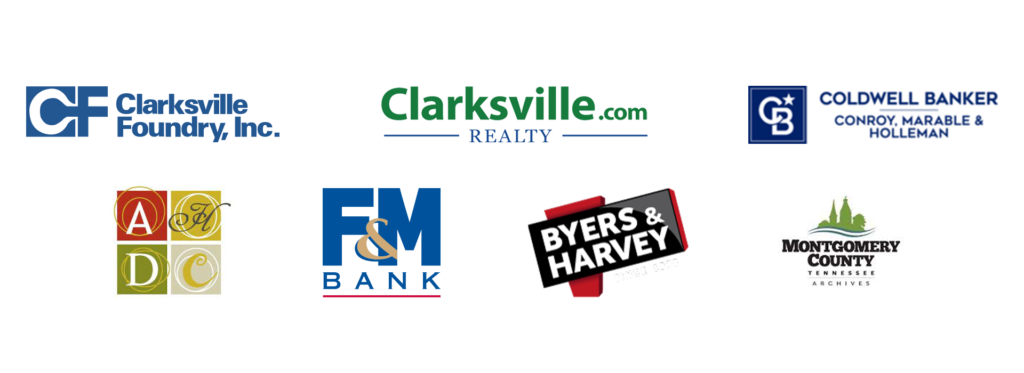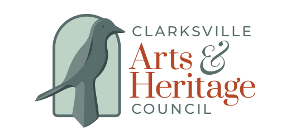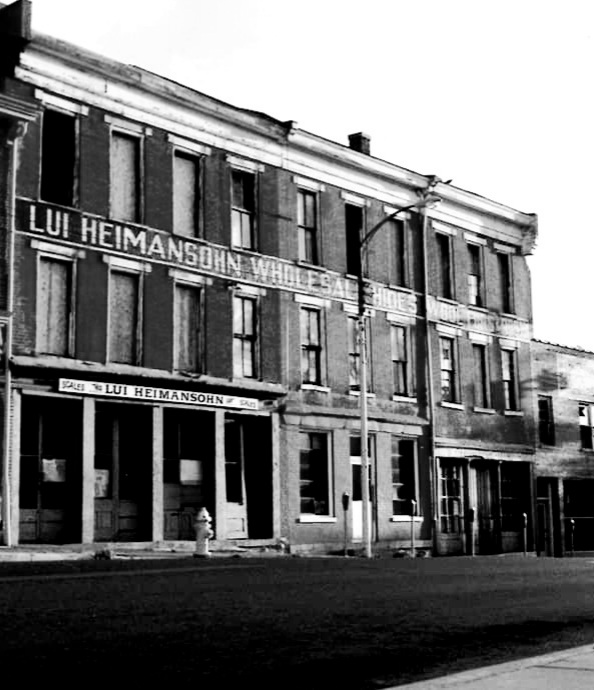
48-54 Franklin Street
Originally part of Lot 75 of the old Town plat, this was one of the last two lots on Public Square purchased by the Heimansohn family. This three-story brick business house was occupied as early as 1842 by local businessmen R. S. Moore and William J. Broaddus under the firm name Moore, Broaddus & Company, dry goods merchants. The Broaddus family, under various names, maintained business interests on this block of Franklin until the late 1880s. H. A. Current acquired the lot and building from some of the Broaddus heirs. In 1896, Current and George Eleazer traded properties and this building became a grocery. Eventually acquired by A. H. Patch, it passed to his heirs who sold it in 1941 to Seymour and Arthur Heimansohn.
The east lot of the four downtown lots purchased by the Heimansohn family, it was originally part of Lot 77 of the Old Town. One of the earliest uses of this building was the dry good store of Rice, Broaddus & Company. Changing owners, it was purchased in 1888 by W. O. Brandon and W. W. Barksdale who had acquired the Tobacco Leaf newspaper in 1881. Although their offices were in the Opera House building, the composing rooms and print shop were in this building. Fortunately, the business escaped major damage from the April 1887 fire, which destroyed many businesses just up the street. In 1892, Brandon left the partnership and Barksdale became the single proprietor of the Semi-Weekly Tobacco Leaf. He and his wife sold the building and lot to Lui Heimansohn in 1919.
Lui Heimansohn was born March 1869 in Latvia, then a part of Russia. Immigrating to the United State in 1891, he was in Jefferson County, Kentucky in September 1894 when he was married to Betty Bergman. By 1896, they had moved to Clarksville where Lui went into the ‘junk business.” Lui and his three sons, Lawrence, Seymour, and Arthur, eventually purchased four buildings on Franklin on the Public Square where they were dealers in everything from tires to furs and ginseng. One of Clarksville’s oldest businesses, they remained at this location until 1985 when they moved to Gatlin Street.
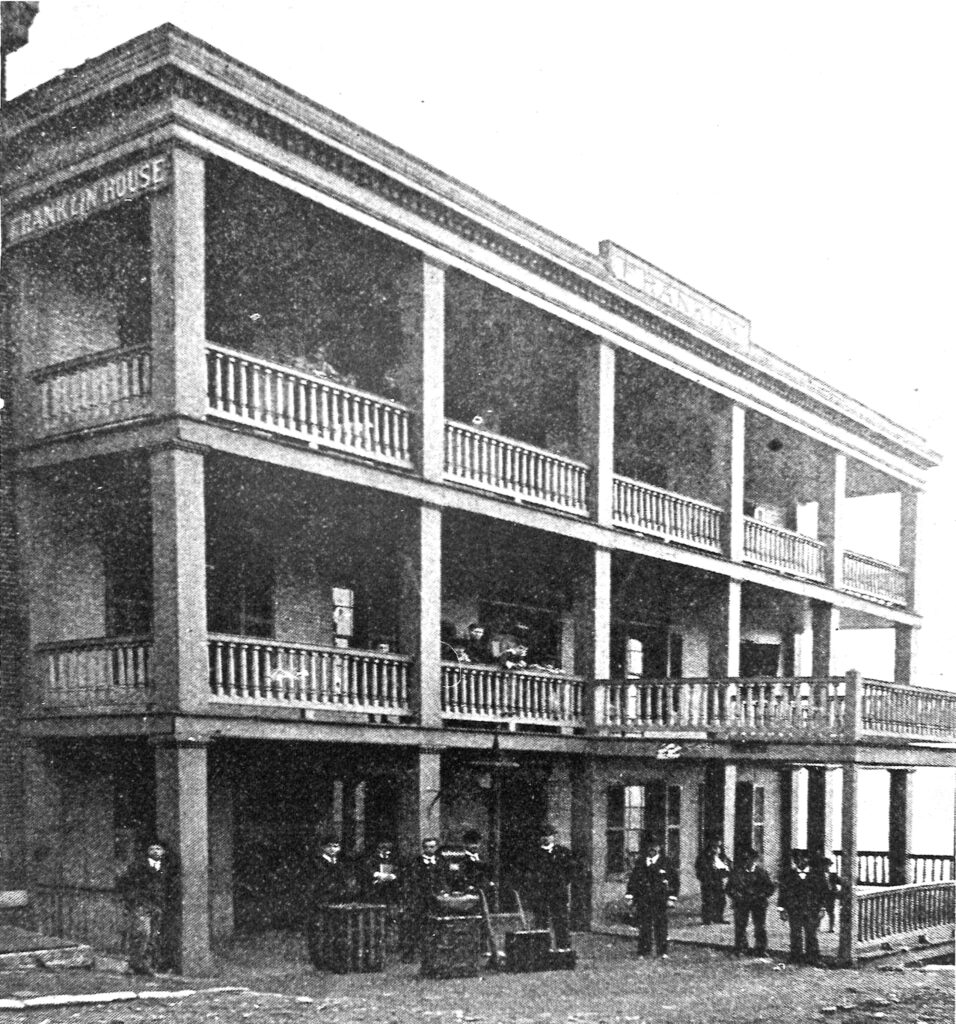
50 Franklin Street (Franklin House)
As early as November 1819, on this site – lot 73 and part of lot 75 on the Public Square of Old Town – the tavern of Eli Lockert was well established. Sold for $4,000 in 1840 to Joseph Johnson, the property again changed owners in 1844 when what was by then called the Franklin House sold to Joseph Chilton. Chilton operated it as a “barr” and added to the original structure. Although it remained in Chilton’s possession, there were several proprietors – T. V. Cannon, Stanfill & Anderson, Action Young, and A. M. Lyles. During the 1850s the Franklin House was host to numerous travelers, salesmen, tobacco merchants – passengers who mostly arrived in Clarksville by riverboat.
The Franklin House was sold to Dr. C. L. Wilcox in 1855. Wilcox had made several propositions to the city regarding upgrading the hotel and even changing a portion of Franklin Street, none of which were acted on. He referred to the property as “the tavern” when it was sold in 1857 to Edward Spurrier, proprietor of the Graysville Inn. During Spurrier’s ownership, the hotel was enlarged and renovated and became known as the National Hotel. Following the War, proprietors were S. B. Grant, followed by T. D. Scott.
In 1875, Bringhurst and Co. took over the management of the hotel – renovating, refitting, & improving – and re-opening under the name Franklin House. The hotel once again became well known throughout the state for its hospitality, service, and excellent food. Located across the Public Square from the Tobacco Exchange, the hotel was especially convenient for tobacco merchants whose business brought them to Clarksville. In 1893, Bringhurst purchased the hotel, and in 1902 sold it to the family-owned Franklin House Hotel Company which retained ownership until it was sold in 1933 by Mrs. Lula Bringhurst Epperson.
Following the 1933 sale, the Franklin House declined into the Franklin Apartments, a boarding house and a long way from the hotel’s 1850s heyday and the return in the 1880s to gracious service and hospitality. A spectacular fire destroyed the old building in October 1952. The property once again changed owners and is now the site of the F & M Bank.
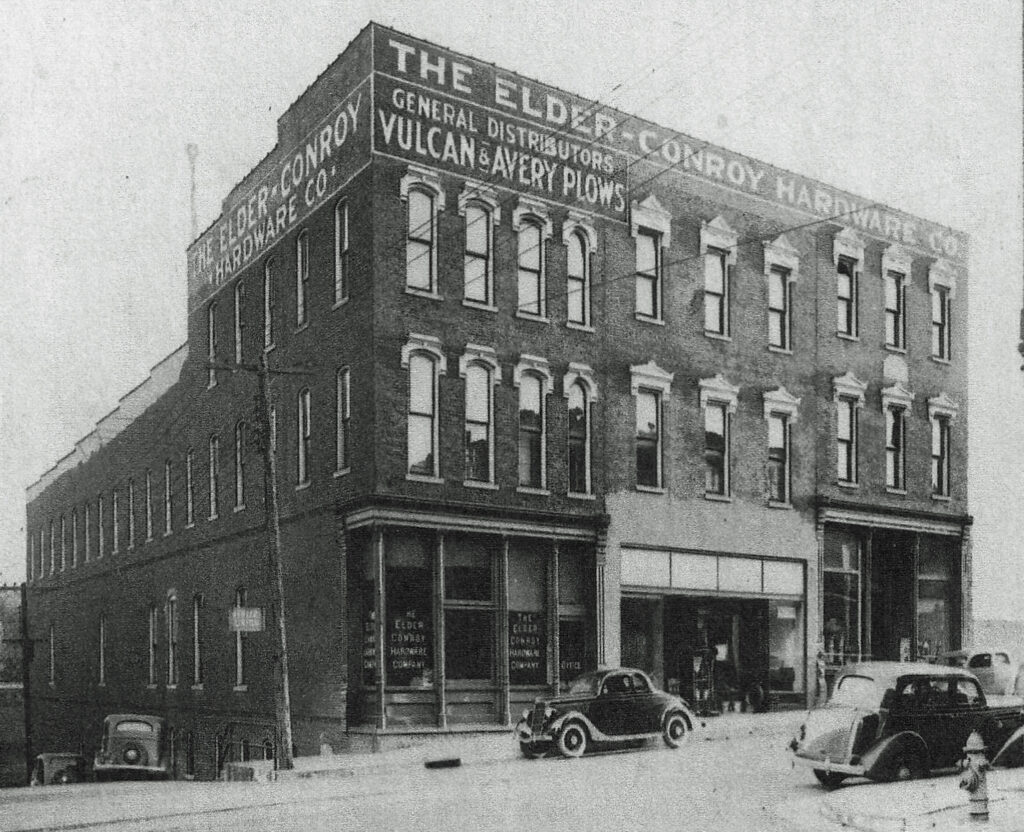
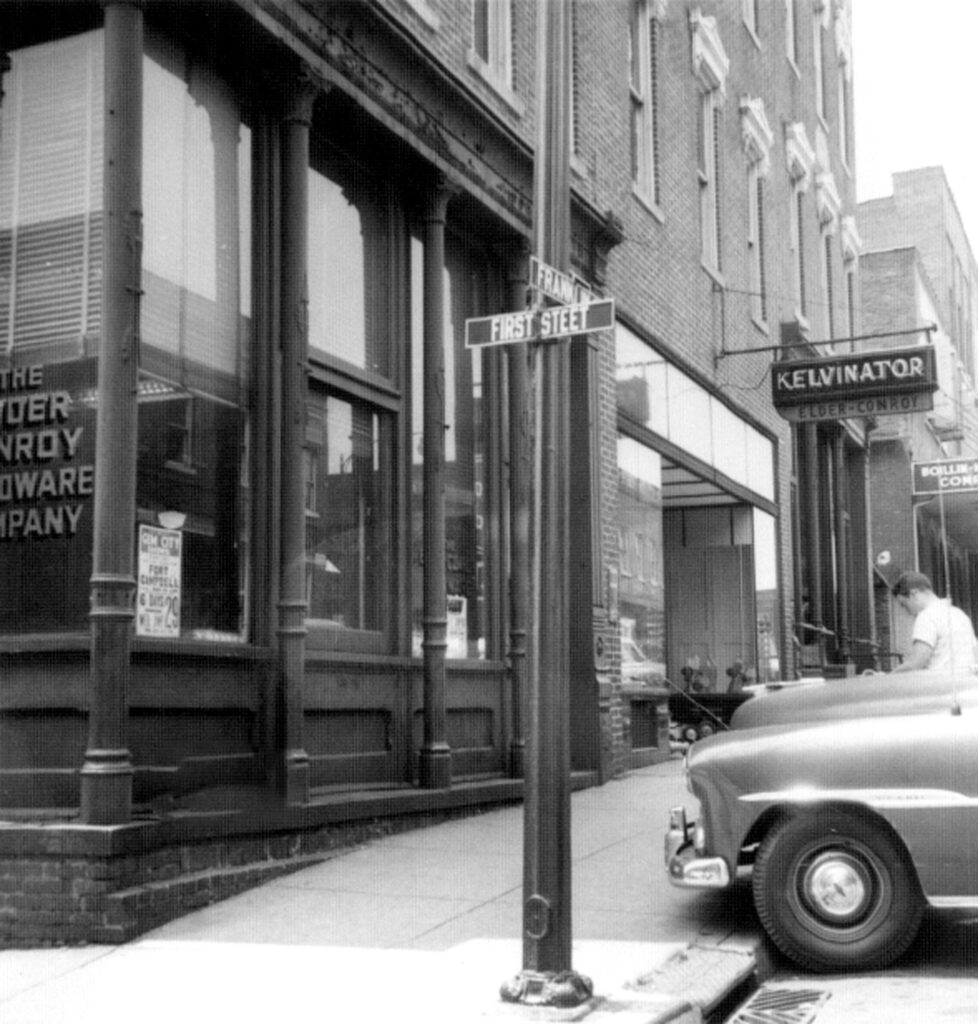
94, 96, 98 Franklin Street
Long before the Elder-Conroy Hardware Company, this block of Franklin Street was home to a diverse business community. The three buildings that became Elder-Conroy in 1912 each had separate owners and businesses. The Bowling building, number 94, had housed not only a variety store and Bowling & Wilson Boots & Shoes but also the Armory and rifle range for Company H of the First Tennessee Regiment.
Numbers 96 and 98 Franklin was the McKoin & Bailey Furniture Manufacturer and sales rooms from at least 1851 until 1866. These buildings were occupied in the 1860s by Fox & Smith (hardware), Pirtle & Hewitt (drugstore), a warehouse used by Q. C. Atkinson, and the storehouse of Watts, Slaughter & Co. (dry goods & clothing). Lockert & Askew, one of the largest retail drugstores in the entire South, occupied 96 for many years.
98 Franklin became known as the Pitman & Ely building after the demise of McKoin & Bailey. A multitude of small shops made their home here – a barber shop, dentist office, cobbler, fish market, and even a telephone office at one time. The large third-floor meeting room hosted various groups, among which was the local chapter of the Ancient Order of United Workmen, the first of the fraternal benefit societies organized after the Civil War. Another fraternal organization, the Queen City Tent [Chapter] of the Knights of the Maccabees, also met here in the late 1890s.
Elder Brothers’ Hardware which began in 1865, was incorporated in 1899 and became The Elder-Conroy Hardware Company, a strictly wholesale hardware business that sold virtually everything imaginable except grocery items. In 1912, they purchased the three building block on the south side of Franklin and began remodeling. A spur line of the Louisville & Nashville Railroad to Franklin Street was also begun to reach the rear of Elder-Conroy and then-neighboring business Hurst-Boillin. In its heyday in the 1930s and 1940s, goods for country stores were supplied to 30 counties in Tennessee and Kentucky. The closing of the store in 1980 was the end of an era in Clarksville’s business history.
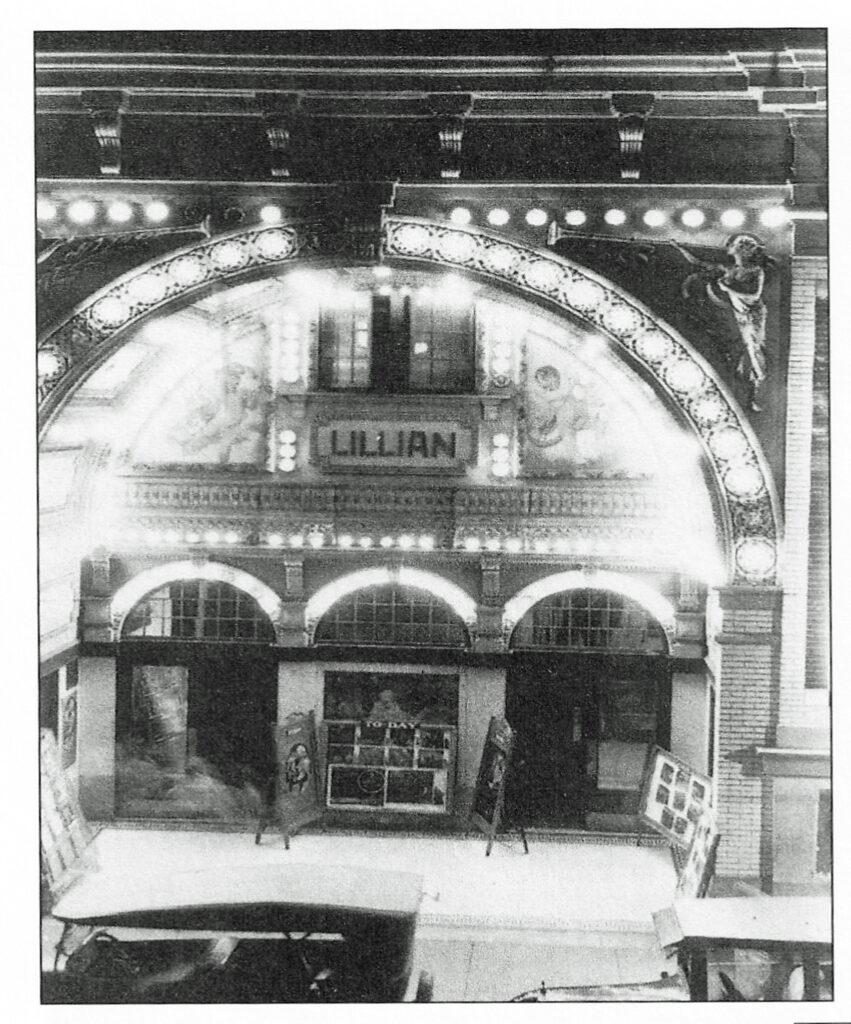
100 Franklin Street
Joseph Goldberg, a native of Russia, came to Clarksville from Chicago. At first a peddler, he became a pioneer in the motion picture business of Clarksville. He acquired property from the George Alwell estate and on this site, in 1912, he built the Lillian Theatre, named after his daughter. Described as one of the finest movie houses in the South, it was destroyed in the December 1914 fire that also destroyed Elder’s Opera House. Mr. Goldberg began rebuilding, and in October 1915, reopened the theatre, again named the Lillian. The theatre continued in operation until 1936. Eventually, the theatre was sold to Crescent Amusement Company who reopened it as the Roxy in 1941.
Thomas Alwell purchased part of Lot 82 of Old Town in 1839 from Samuel McFall. Located on this lot were two brick storehouses, a two-story brick house, and “the family mansion.” Known as the Alwell Block, it passed to his nephew George Alwell who conducted various business endeavors of his own from this corner – toys, confectionery, groceries & produce, dry goods, agent for Port Royal Mills, & a book shop. One of the busiest parts of Franklin Street, there were many others over the years associated with this block – Shackleford & Rivers and Kimble & Foster, attorneys, John N. Neblett, tin, copper & sheet iron, Thomas Walsh, dentist, C. O. Faxon, book store, M & W. Kleeman, clothiers, J. L. Blanton, clothing, V. L. Williams, hats & boots, Hay & Hyman, auctioneers, Cornelius McFall, barber, Pleasant Young, tailor, H. Westenberger, boos & shoes, Masonic Lodge, 3rd floor, Rubenstein & Schlinder, dry goods and Rosenfield, Joseph & Co.
The Great Fire of April 1878 threatened but did not destroy the Alwell property. However, in January 1880, an internal fire destroyed part of one of the buildings before it was controlled.
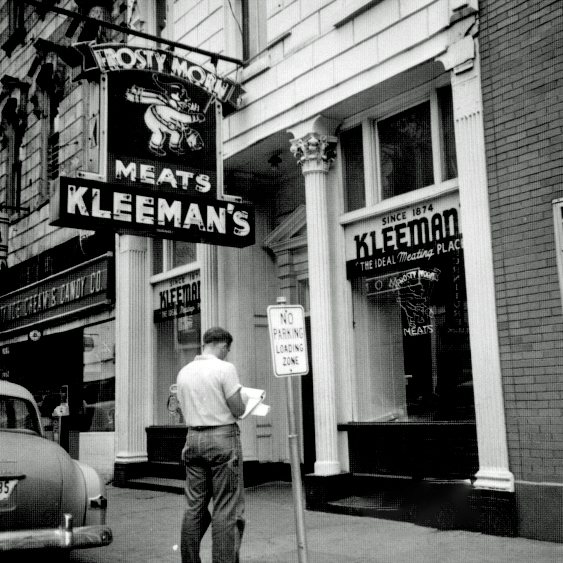
104 Franklin Street
About 1852-1853, after the death of their parents in Bavaria, brothers William and Max Kleeman came to the United States. Max settled in Cincinnati, later moving to central Illinois where he opened a dry goods store. William, having been trained as a butcher, followed that occupation while living in New York. About 1862, he and his small family moved to Shelby County, Illinois before coming to Clarksville in 1865. In December 1865, Kleeman & Co, on Franklin Street, advertised “Gentlemen’s Fine Clothing,” a mercantile business that lasted until 1878. While engaged in the retail business, his building also housed Walter Neblett, dry goods, Leo Mainhardt, telegraph operator, W. M. Long, agent for Singer sewing machines, Long & Walthal, agents for St. John sewing machines, and Philip Lieber, dry goods.
In 1874, Kleeman returned to his original occupation, opening Clarksville’s first daily meat market at what was 102 Franklin. He was renowned for his fresh meats; one of his long-time customers was William Bringhurst of the Franklin House, widely known for his excellent meals. Not only did he deliver locally in Clarksville but orders from Paris, Tennessee to Bowling Green, Kentucky were delivered by rail. Providing fresh beef and other meats was a constant challenge. He went to the farmer, on horseback, by water, and rail. The first livestock brought in over the IA& T railroad was a carload of sheep consigned to Kleeman. One of his best-known suppliers was Captain Frank P. Gracey who raised champion Holstein cattle and Cheshire hogs. His shop boasted of having the only professional sausage maker in the city and fresh “wiener wurst” was always in stock.
His market building continued to include other businesses – Henry Auling, jeweler & watchmaker and I. W. Hiett, vegetables and fruits.
After William Kleeman’s death in 1914, his son Ike continued the business. In 1934, Irvin S. Kleeman grandson of William, and E. C. Moore became the active partners.
In February 1937, a huge fire broke out within the three-story brick building causing extensive damage; neighboring Purity Candy Kitchen and the Western Union office were undamaged and open for business the next day. Kleeman’s survived the 1937 fire only to be completely destroyed, along with the next-door Tots and Teens Shop, in another fire in November 1964 which began in the neighboring Varsity Lounge building.
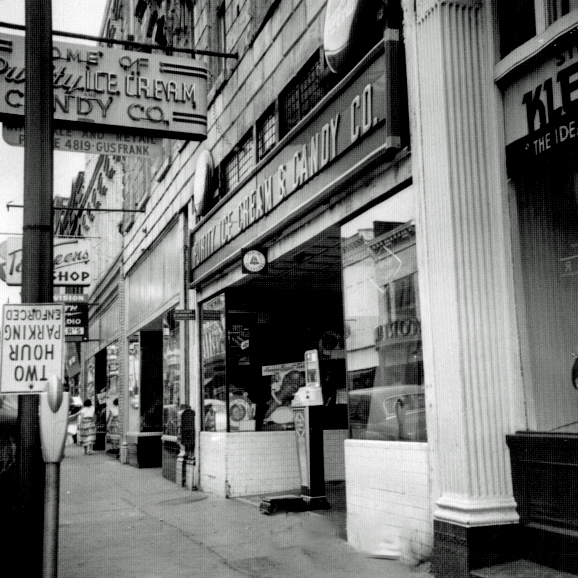
106 Franklin Street
The Purity Ice Cream & Candy Kitchen was one of three “confectioneries” to occupy 106 Franklin.
As early as 1853, G. A. Ligon & Company had a grocery and confectionery establishment next door to the Franklin House on Public Square. As a young man, E. B. Ely began his career as a baker for Ligon but in 1859 opened a confectionery on Franklin where Wells Fowler’s jewelry shop had been earlier. By 1867, they became partners, as Ligon & Ely, and created an “Ice Cream Saloon” at Ely’s building on Franklin.
Both men were from early & prominent local families. George Augustus Ligon was born in 1824 in Virginia, moved to Kentucky, and by 1850 was located in Clarksville. He served as a city alderman and was the mayor of Clarksville three times. Edward Baker Ely was the son of Jesse and Charlotte (Jamison) Ely. His mother was the daughter of William Caldwell Jamison, the first Montgomery County Court Clerk.
The Great Fire of April 1878 completely destroyed the Franklin Street building but Ely was almost immediately rebuilt. Ligon & Ely boasted not only ice cream of sweets of every kind. George Wollenhaupt of Bremen, Germany met Ely in Louisville in 1871 and came to Clarksville with him. He took charge of the bakery and was employed by Ely until about 1895 when he went into business for himself. Ely retired about 1909.
The Clarksville Candy Kitchen began in 1912 as a small business operated by brothers George and Sam Sardis, natives of Greece. Both men became naturalized citizens and married local girls. In March 1919, they purchased the three-story building formerly the home of Ligon & Ely’s business and began remodeling for their grand opening in August as the Purity Candy Kitchen. In 1921 they acquired the Dixie Fruit Company. In 1922 they installed a giant 500-gallon ice cream processor which proved to be very popular with Clarksvillians. Additionally, by 1943, the Sardis brothers had the Dixie Café on Franklin, Nick’s Place, a small café, and the Dixie Eat Shoppe in Erin. In two separate transactions in 1946, as they retired, the brothers sold the Dixie Fruit Company and the Purity Candy Company.
Two years later, in 1948, Gus W. Frank of Nashville bought the Purity Ice Cream Company. By 1957, it had become the Varsity Lounge and was in business in 1964 when a fire broke out in the building. The fire spread next door to Kleeman’s and the Tots and Teens Shop, completely destroying all three buildings.
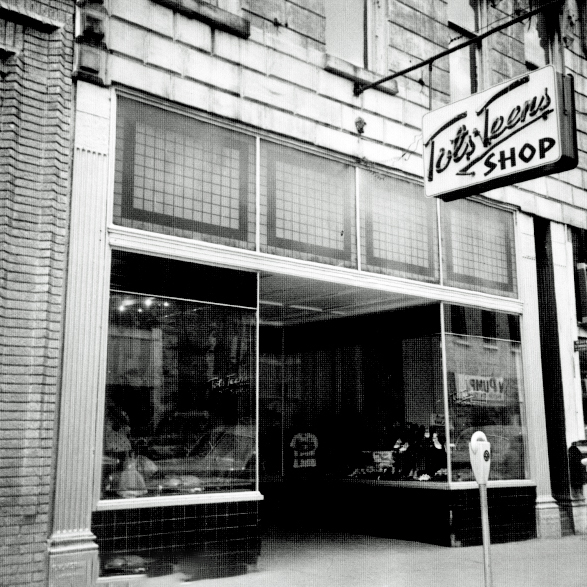
108 Franklin Street
Owned jointly by David Lee and Mrs. Otys Evans, Tots-Teens Shop, a specialty shop for infants through teens, opened in March 1945. The site was leased from members of the Friedman family who had purchased the building in 1921 from Joe Goldberg. Except for a brief period, Mrs. Evans had already worked with Lee for the past ten years. The shop was very well received and was a success. However, disaster struck on 23 November 1964 when a fire completely destroyed the Tots-Teens Shop as well as adjacent Kleeman’s Meat Market, and the Varsity Lounge, threatening the Roxy Theatre and Brenners. The street level of the shop was not directly damaged by fire but the upper floors collapsed and crashed through the first-floor ceiling and ruined the merchandise.
Prior to Tots-Teens, in the 20th century, the building had been owned by Edward B. Ely who sold it to Caroline H. Cooke who sold it to James Hanratty. Occupants of the building included B. G. Hattler, Billiard Parlor, the Clarksville Daily News, the Elite Theatre, and the grocery of Henry T. Grizzard.
Following the Civil War, during the ownership of Ely, the site was filled with various businesses. Among these were W. H. Armstrong, photographer, C. L. Cooke, jeweler, Shepherd & Stout, dry goods, W. P. Lindley, painter & paperhanger, Thompson & Scott, dry goods, James L. Lockert, home furnishings, and W. A. McGill, artist. During the 1878 fire, the original building, believed to have been built by Wells Fowler, was a complete loss. Ely rebuilt almost immediately and the site was once again filled with business houses. Prior to the War, a few of the occupants of “Fowler’s Hall” were J. M. Glascock, harness & saddlemaker, Hughes & Co, musical instruments, D. Kohn & Co, ready-made clothing, Garvin & Evans, house, sign, & fancy painters, Charles Barnum, jewelry & watch repair, T. B. Harrison, saloon, and the owner, Wells Fowler, silversmith and jeweler.
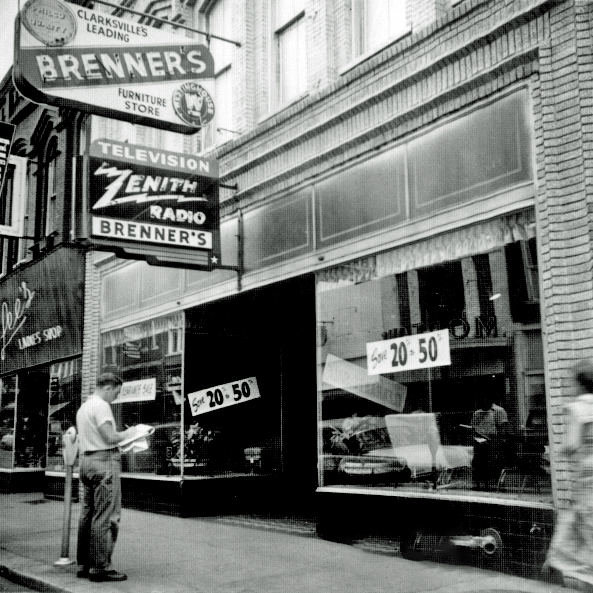
110 Franklin Street
In 1866, David Kincannon, a “tinner” by trade, and his family moved from Cleveland, Bradley County to Clarksville. Opening a tin shop at this location, he and James J. Hamlett formed a partnership which lasted until January 1873 when Hamlett left to open his own business. In June 1866, Kincannon and J. Wood had purchased a lot and building on Franklin from Thelbert Covington which in turn had been purchased from John Nick Barker. By 1872, the mortgage was paid in full and Kincannon’s new partners, Jonathan & Frank Wood, formerly of Chattanooga, had purchased Hamlett’s interest.
Kincannon, Wood & Co sold not only tin and sheet iron ware but also cooking stoves, willowware, Queensware, glassware, cutlery, home furnishings, and myriad other items. They became a fixture in the Clarksville business world of the late 1800s.
In early April 1878, a fire broke out in one of the frame buildings in the rear of Kincannon’s. Before help could arrive, other buildings caught fire and from Kincannon’s, the fire spread and destroyed acres of downtown, including the Courthouse. Kincannon was one of the first to rebuild and rebuilt a much larger establishment; in 1886, they added even more space to the Franklin Street buildings.
In October 1888, David Kincannon died and was buried at Greenwood. Soon after the death of his widow, L. Fannie (Britton) Kincannon in June 1896, the family began selling off stock. In 1898, the Kincannon children sold the Franklin Street property to the McGehee Brothers.
110 changed owners several times, eventually becoming Brenner’s House Furnishing Store in February 1919; the original store was on the north side of Franklin. In September 1931, Brenner Furniture Co, Inc moved across to the south side of Franklin, having purchased the business in 1925 from Reuben Brenner. The front of the building was changed from its 1880s look to a more modern entrance and the interior was remodeled. Brenner’s sold radios, televisions, refrigerators along with furniture and home furnishing items.
In 1980, long-time Brenner employees, William S. & Fannie Barrett and Earnest & Annie Ruth Hardison became co-owners. They continued with the business until they retired, both after 50 years. Brenner’s closed in September 1996.
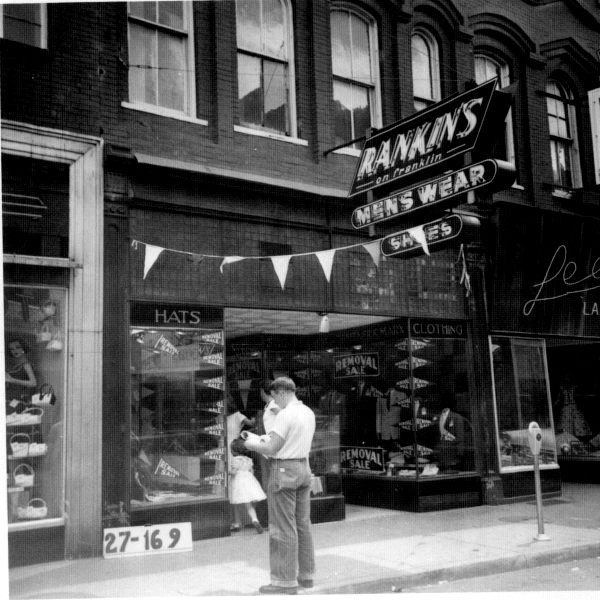
114 Franklin Street
In 1877, J. Wood, partner of David Kincannon, gave this lot and building to his daughter, Lizzie. At that time, J. G. Joseph operated a dry goods establishment and maintained his residence in the building.
Clarksville must have been an attractive place to go into business. Oscar Tate Rankin and Patrick Tate Ferguson of Harriman, Roane County came to Clarksville as relatively young men and began a new venture as business partners. They opened their new shop of “gents furnishers and clothiers” in 1902. In 1904, the firm moved to the building they would buy from Lizzie (Wood) Batts in 1913. Paul Edmondson, native of Montgomery County and son of Thomas Edmondson, began his association with the store in 1924. He had been affiliated with the clothing business since he was a teenager. In 1930 when P. T. Ferguson sold his half interest in the stock and fixtures, Edmondson became the junior partner in the new firm, Rankin & Edmondson.
Fire has been a reason for major damage in Clarksville’s business center for many years. In April 1935, a fire originating in the basement damaged the entire stock of menswear, resulting in, not only a clearance sale, but a remodeling of the store itself. In July 1940, O. T. Rankin acquired Paul Edmondson’s interest in the store and it became known as Rankin’s.
By 1953, the store at 114 Franklin had become William Lane Men’s Wear, and the “regular” store moved up the street to 132 Franklin where a going out of business sale took place in 1983.
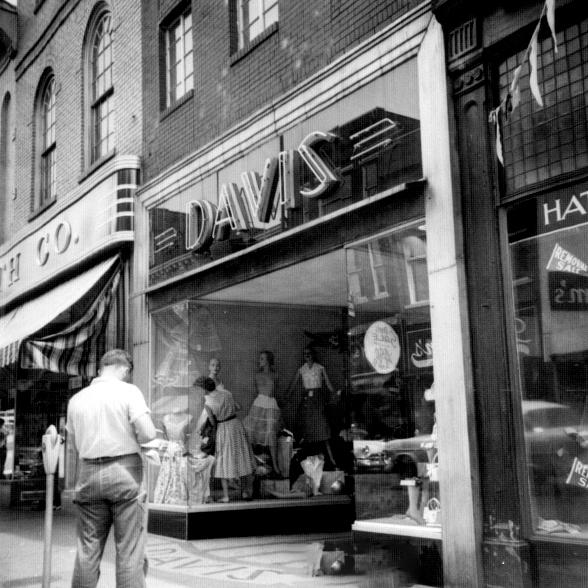
116 Franklin Street
Samuel Hodgson purchased this lot and the brick building on it from Richard Martin in 1858. It became not only the millinery shop of Mrs. Julia (Kearney) Hodgson and her business partner but the residence of the Hodgson family. This building was one of the structures lost in the Great Fire of 1878. Samuel Hodgson was among the first to rebuild and reopen for business – his marble works on 2nd & Franklin and her millinery shop down the block on Franklin. Mr. Hodgson died in 1894 and in 1900, Mrs. Hodgson retired and went to live with her son Lee on Munford Avenue. She was living there when she became ill and died in 1918 after a brief illness.
The building was rented for a few years to Dr. J. E. Justice who was the proprietor of the Justice Drug Company. Dr. Justice, a native of Cheatham County, came to Clarksville about 1911 after several years in Nashville. In 1915 he was nominated to serve as the State Pure Food & Drug Inspector.
In 1920, the Hodgson sons, acting as executors of the estate, sold the property to Sam Goldfine who only had the property a year before selling to Mr. & Mrs. B. A. Cushman. Once again, a fire caused substantial loss. In November 1929, a fire began in the Mammoth, next door, on a Sunday morning. Smoke and water damage to the Cushman store was considerable, leading the store to announce its first “water and smoke sale.”
The Davis building had more than its share of fire problems. By 1941, the building was leased to the Davis Department Store and in February 1941, they had an electrical fire which temporarily closed the store. Another small fire caused slight damage in October 1942. And, in Jan 1951, the store was gutted by a huge fire that fortunately, was confined to the Davis Store. After a complete overhaul of the building, the Davis Store reopened in August 1951. In 1983, the last Cushman family member sold the store to James Wyatt, a photographer who had his studio there.
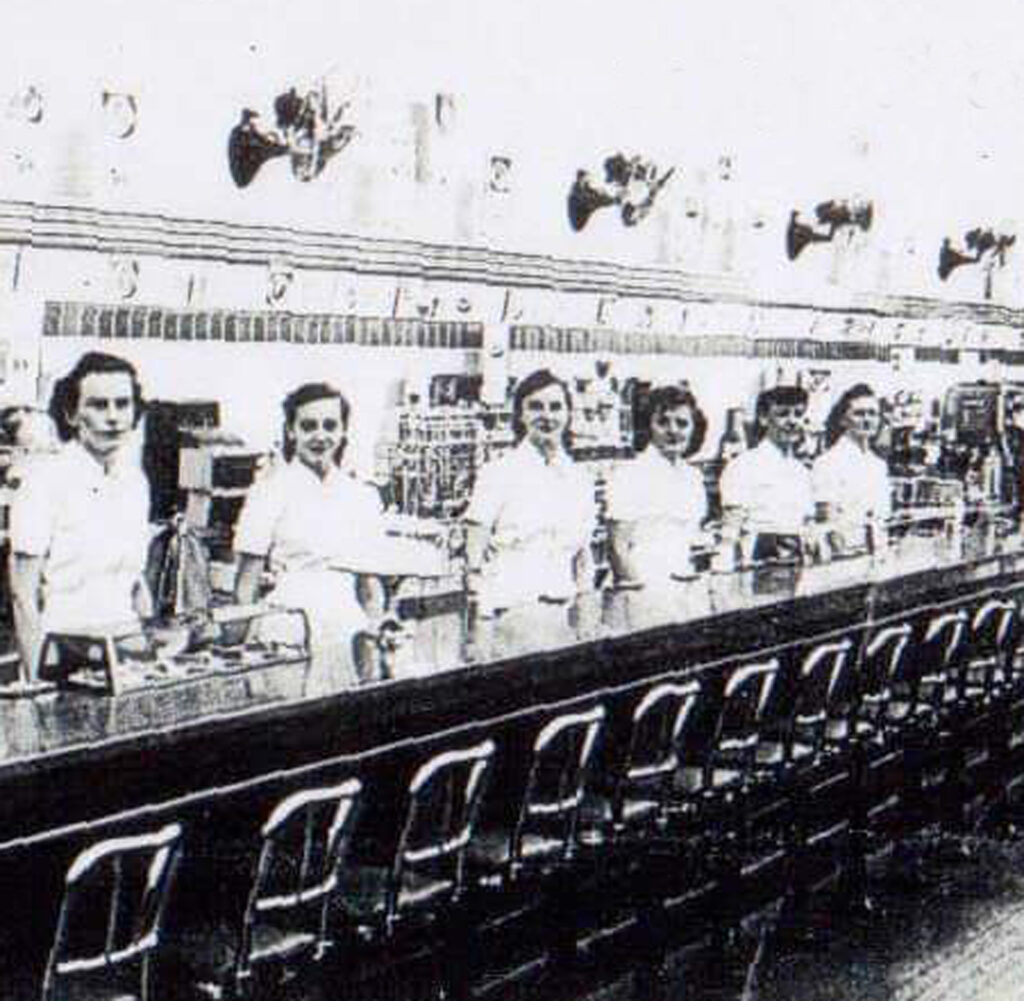
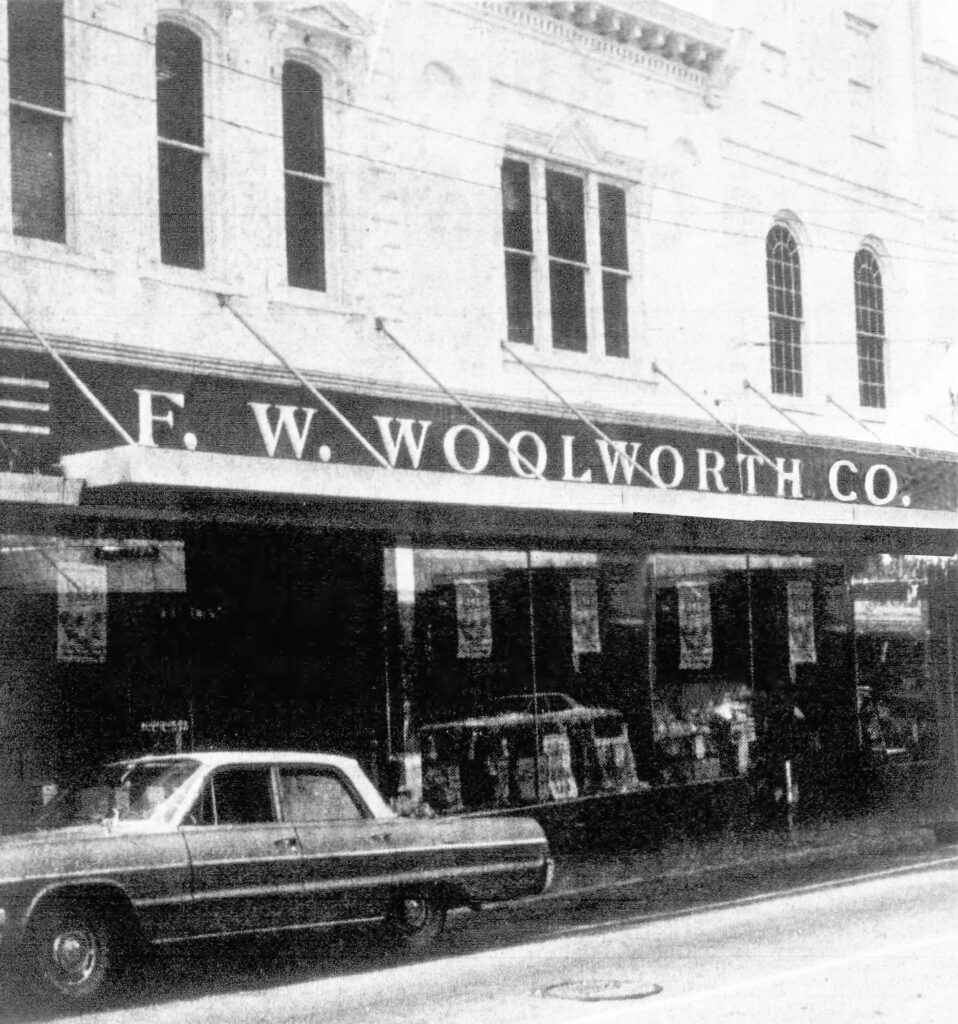
118, 120, 122 Franklin Street
Woolworth’s 5 & 10 Cent Store opened on 5 May 1917 on Franklin Street. Before opening time at 8 that morning, there was already a long line of new customers. An estimated 4,000 people were in the store that morning. Woolworth’s became a mainstay on Franklin, several other stores of all types advertised how close they were to the store. And it grew until it was the width of three stores.
In the 40s, the lunch counter was a popular downtown eating place. At first there were only eleven stools but the counter & seating was expanded in 1948. There were fans along the wall opposite the counter to keep customers cool. All the food was prepared fresh as this was before microwaves, freezers, and air conditioning. This was also the beginning of Camp Campbell; Clarksville was full of soldiers from the new Army post. Woolworth manager, W. E. Gass hired many military wives.
In July 1969, after more than 50 years in Clarksville, the F. W. Woolworth Company announced that the store would close at the end of the year.
Curtis Bellamy leased the old Woolworth building from owner Immaculate Conception Church, and in April 1972, held his first auction. Bellamy Auction House sold literally everything imaginable – furniture, toys, pizza ovens, antiques, baby furniture, coin collections, and, according to one of their advertisements, a tub and kitchen sink!
Louis LaHiff saw the promise of the old building on Franklin and in the summer of 1980, the old Woolworth’s became the Franklin Arcade. Home to a variety of shops, the arcade featured a painting by Peg Harvill taken from a photograph of Franklin Street in 1908. Downtown revitalization continued with other property owners remodeling and renovating for new shops and also, downtown living.
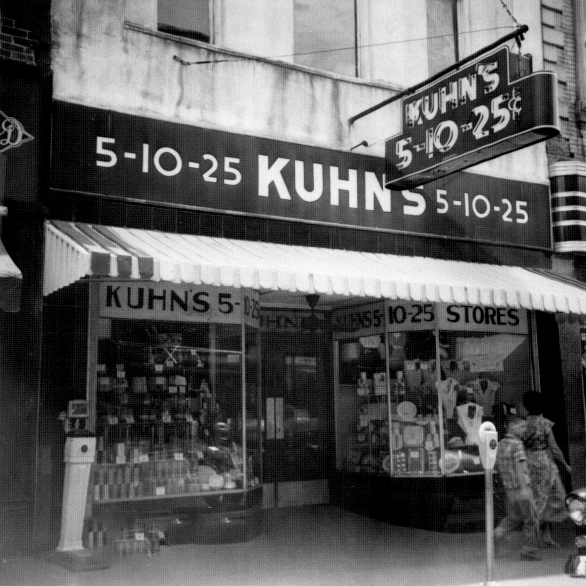
124 Franklin Street
Kuhn Brothers, of Columbia, Tennessee, began a variety store chain in Tennessee and across the South in 1913. The Clarksville store was the thirty-second store, opening in June of 1928 on the north side of Franklin Street in the former Gossett & Bell furniture store. An announcement made in August 1939 stated that Kuhn’s 5 & 10-cent store would move directly across the street to the former location of the National Stores. Anticipating the move, a remodeling was underway by owner Morris Latner. Another remodeling took place in 1949 with a grand re-opening of the store.
The store managers had always been men, and mostly transferred to and from Clarksville by Kuhn’s from other locations. Mrs. Bill Jobe became the manager on 1 July 1949 and served as manager of the Franklin Street store through at least the end of 1954. The former Mary Louise Miller, she was married to Bill Jobe. Mr. Jobe was a partner with Watson & Jobe’s Men’s Store, also in downtown Clarksville. The owner of the Franklin Street property was Morris Latner who had moved to Clarksville from Nashville in 1919 and was manager and later part owner of Pearson’s. He and Max Wise bought that business in 1948, later selling to Wise when he retired.
Kuhn’s remained in business until 1976-1977. The property, which had been inherited by the Latner daughter, Betty Latner Shepherd, was sold by her son, Charles Morris Shepherd, in 1977 to James and Joyce Petty.
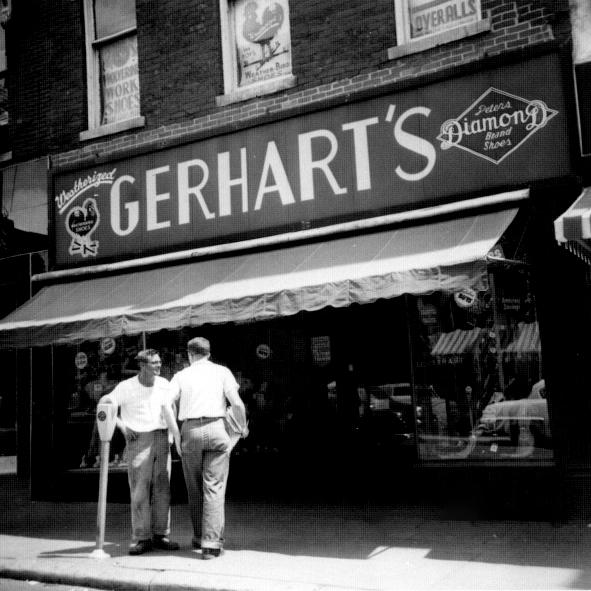
126 Franklin Street
Nathaniel V. Gerhart, the enterprising dry goods merchant, is the senior member of the firm of N. V. Gerhart & Sons, who do a thriving business on Franklin Street, between First and Second. He is a live, wide-awake citizen, and enjoys the fullest confidence of the Clarksville public. Associated with him are Isaac P., Charles C, and Harry C. Gerhart, and the commodious store they conduct is twenty-five by one hundred and ninety feet in the clear, and this is continually well stocked with the very freshest goods in the firm’s line. Mr. N. V. Gerhart was born in Dauphin County, Pennsylvania February 7th, 1827, and is a son of Isaac and Sarah V. Gerhart, being the youngest of the five children. Isaac Gerhart was a native of Bucks County, Pennsylvania, and for fifty years was a member of the German Reformed Church. N. V. Gerhart was educated at Gettysburg, Pennsylvania, and in 1853, located at Louisville, Kentucky, where he remained until 1873, when he came to Clarksville, where he has since lived and prospered in every way. While at Louisville he wedded Miss Ann Eliza Piedmont, and to them were born Isaac P., Charles C., Joseph H., Ludia (now Mrs. Thomas Cross), Harry C., and Bayless W. Gerhart. The family is an exceedingly happy one, and all are recognized as believers in the Episcopal doctrine of the Holy Writ except Mr. N. V. Gerhart, who is a Presbyterian.
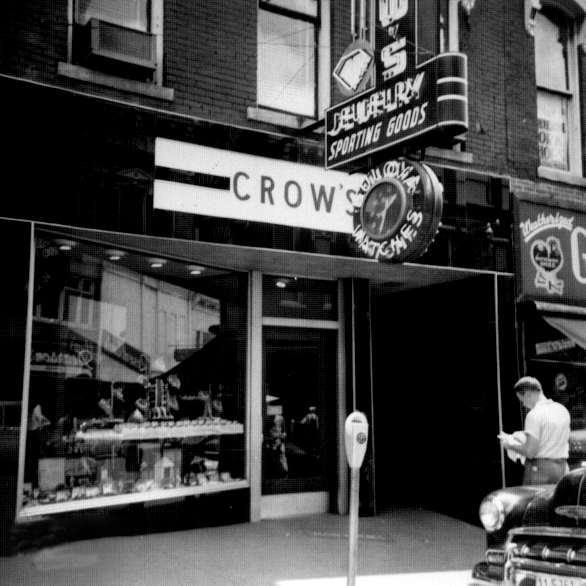
128 Franklin Street
One of the earliest occupants of this address was the young druggist, Samuel Brown Stewart. “Sam” Stewart was the son of William May and Jane B. Stewart. William Stewart is best known for his involvement with the local iron industry and, even more so, for this association with Stewart College. S. B.’s wife, Medora Judkins, was the niece of John Couts and great niece of Cave Johnson. He entered the profession as a clerk with E. R. W. Thomas and soon opened his own establishment on the Public Square. In late 1872, construction began on his new business house on Franklin Street, near the courthouse, where he opened for business by January 1873.
The property was next occupied as a jewelry store by Louis Gauchat. Originally from Switzerland, he came to the United States in 1866, made his way to Allensville, Kentucky, and by 1876, had moved to Clarksville and acquired S. B. Stewart’s “old stand.” He advertised as a watchmaker and jeweler. His business was completely destroyed during the Great Fire of 1878. One of the stories told about the fire was that Mr. Gauchat packed a trunk with eight to ten thousand dollars’ worth of jewelry and sent it to Caldwell & Shelton’s livery stable where it was supposed to be safe. After the fire, he went to retrieve the trunk but found that the stable and all its contents had burned. But he rebuilt and was once again successful in his business endeavors.
The next owner was W. W. Winters who purchased the building in 1918. He leased the building to several different people until 1943. Max Adler had a tailor shop for several years. David Judah, former owner of The Mammoth department store had a loan business. F. H. Fuqua had an insurance office there, and one of the Hodgson’s had an upholstery shop.
The next transfer was to John Cullom Crow who moved from Stewart County to Clarksville and established the J. C. Crow Jewelry Company in 1919. He purchased the building where he was already located and doing business in 1943. During the years he had his shop on Franklin, he was also very involved in church activities, first at the Washington Street Church of the Nazarene, then the United Brethren and later, different congregations of the Methodist Church. Dr. Dixie R. Kirtland had an optometry office at the jewelry store for a while. Eventually two Crow family members – Dr. L. R. Crow, optometrist, and H. S. Crow, contractor – also had offices there. Mr. Crow died in 1952 but the business was continued by his sons, Charles W. and James W. Crow. Charles Crow became Mayor of Clarksville. In 1970, Crow’s Jewelers had a huge going out of business sale which brought the almost fifty year old business to a close.
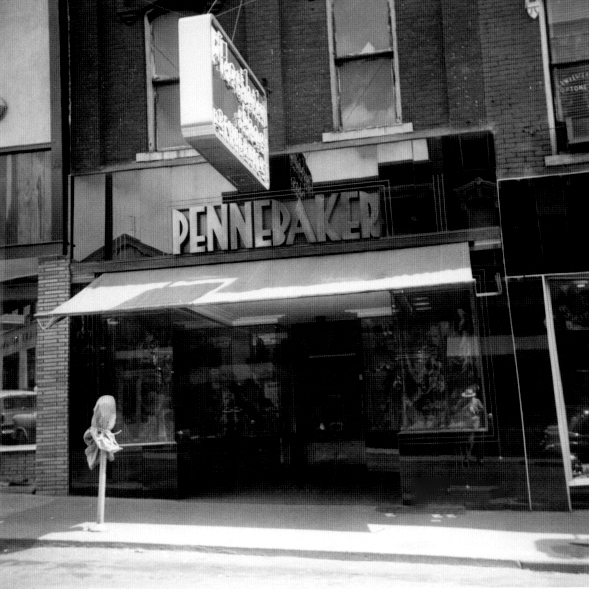
130 Franklin Street
When Pennebaker’s announced their going out of business sale in June 1980, it was the close of one of Clarksville’s oldest businesses.
Leander Aquilla Pennebaker was born in Jasper County, Texas in 1868. On his father’s side, he was a descendant of a Dutch family who had originally settled in Pennsylvania; his mother was a descendant of a French Hugenot family who had settled in South Carolina. When a young man, Pennebaker had moved to Oxford, Mississippi and opened a store. He moved to Clarksville and, in 1894, joined B. G. Cloar who had recently opened the Famous Shoe Store in 1893 in the Turnley building on Franklin. The Turnley property had originally been owned by B. O. Keesee; this site was where Pennebaker’s operated their store until they closed. Mr. Cloar was a native Tennessean who was already connected to wholesalers in St. Louis dealing in shoes. Since he continued traveling for the company, Mr. Pennebaker ran the firm’s local business. Their head salesman was local R. H. Pickering who became affiliated with the firm in 1894.
Mr. Pennebaker next partnered with Rice Orgain in 1896, still in the shoe business. Mr. Orgain had been a salesman with Stratton’s shoe store. The new firm became Pennebaker & Orgain with Mr. Cloar continuing to travel for a wholesale shoe firm in St. Louis. L. A. later became the manager of the M. L. Cross shoe store. While there, he met and married Eunice Balthrop in 1902. Mrs. Pennebaker was a native of the Henrietta community in Cheatham County, the daughter of John Hartwell Balthrop and his first wife, Mary Jane Gupton. They had one daughter, Mary Frances who married Patrick Henry Cross. They were responsible for donating the Henry home, Emerald Hill, to Austin Peay State University.
Following Mr. Pennebaker’s tragic death by drowning in 1929, Mrs. Pennebaker and surviving business partner, W. B. Pedigo, decided to continue the business. Mr. Pedigo had already been associated with the business sixteen years and had served as assistant and partner for a number of years. Under his guidance, in 1935, the shoe store completed a major remodeling that entirely changed the front entrance and much of the interior.
Mrs. Pennebaker died in 1967 at her home on Madison Street where she and her husband had lived for many years. Mr. Pedigo died in 1976 at his home in Clarksville.
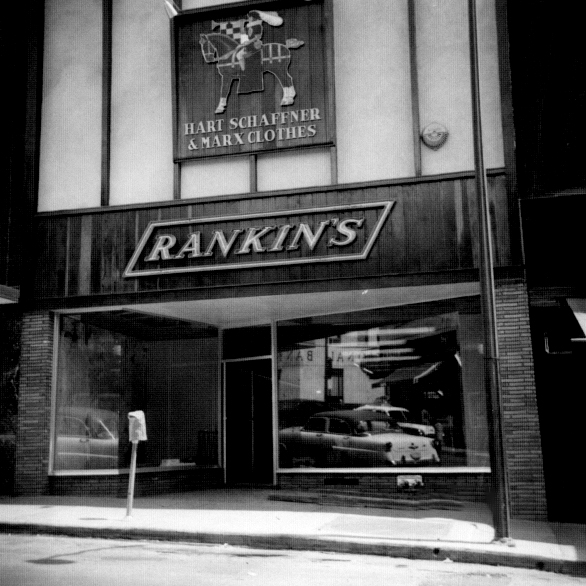
132 Franklin Street
B. H. Owen, executor of the estate of David Newton Kennedy, transferred this storehouse and lot in 1905 to Roberta V. Kennedy, daughter of James Thompson Kennedy, and granddaughter of D. N. Kennedy. During the thirty-odd years she owned this building, there were several businesses and offices located here – Settle-Edmondson (women & children’s clothing), Clarksville Chamber of Commerce office, Clarksville Credit Men’s Association office, Montgomery County Farmers Institute office, and the Clarksville Band. Roberta V. (Kennedy) Latta sold the lot and building in 1937 to Lucy Bailey Clark. “Miss Lucy” was a long time teacher and assistant principal at Clarksville High School. In later years, Oscar Tate Rankin, moved his high-end menswear store from lower Franklin to this site, remaining until the store went out of business in 1983.
Many years previous to Rankin’s, there were at least two tenants of note in this most unusually styled building constructed after the Great Fire. Philip Lieber came to the United State from what is now Germany as a teenager, about 1856. He became a very successful merchant in Kentucky when he set his sights on another opportunity Clarksville. In December 1876, he had the grand opening of his “Trade Palace” in the Franklin Hall building, previously occupied by A. B. Harrison & Son. He sold everything imaginable in the clothing line and even had an agent for a sewing machine company in his place of business. All was well until the fire of April 1878. The Trade Palace was almost a complete loss; Lieber’s estimated losses were $25,000 with only $6,000 covered by insurance. Within a short time he reopened, announcing a giant sale to clear his little remaining stock and was preparing to go on a buying trip. On 1 August, he announced he had rented the ground floor under MacCormac’s gallery and would reopen when construction was completed. The Lieber Trade Palace remained in business several years until, in 1890, Mr. Lieber returned to Louisville, where after a short time, he went into the insurance business. The Clarksville store, now styled Philip Lieber & Son, stayed open for a few more years under Albert Lieber, son of Philip. In 1893, Albert and his family also returned to Louisville and the store on Franklin was closed.
William J. MacCormac, also frequently spelled M’Cormac, located in Clarksville as early as 1855. Born in Edinburgh, Scotland in 1838, he was the oldest son of John and Lydia MacCormac. After visits back to Scotland and serving in the Union Army’s topographical engineer corps, he located in Louisville, Kentucky by 1867 where he was engaged in the grocery business. In 1869, still in Louisville, he was a partner in M’Cormac & Cullen, boot & shoe manufacturers which was also advertised in the Clarksville newspapers. However, he returned to Clarksville at least by 1870 when he was married on 7 November to Mary L. Leonard. She was the daughter of T. D. and Fredonia (Marable) Leonard of New Providence. And, he resumed his photography career. In January 1871, he purchased a lot & house on Franklin from F. M. Doughterty. Many years later this was part of the Woolworth 5&10 store property. In 1872 he bought the property at present day 132 Franklin from Julia Annie Keedy of Logan County, Kentucky. At this time, W. J. & Mary were living in New Providence next to her parents. He traveled extensively and became very well known across Tennessee and the South. He was a member of the American Photographers’ Association and at one time served as vice president. The Great Fire of 1878 devastated his business. The loss on his building and stock was $15,000; his archives of 7000 negatives was also destroyed. His insurance coverage was $2,500. When he rebuilt, the upper story of his building was custom designed for his particular needs. “The picture gallery is beautifully finished. . . having a remarkable skylight . . .” creating the most unique building on Franklin Street. Known to many as the “Dean of Photography of the South,” Mr. MacCormac died at his home at 4th & College on 5 December 1912.
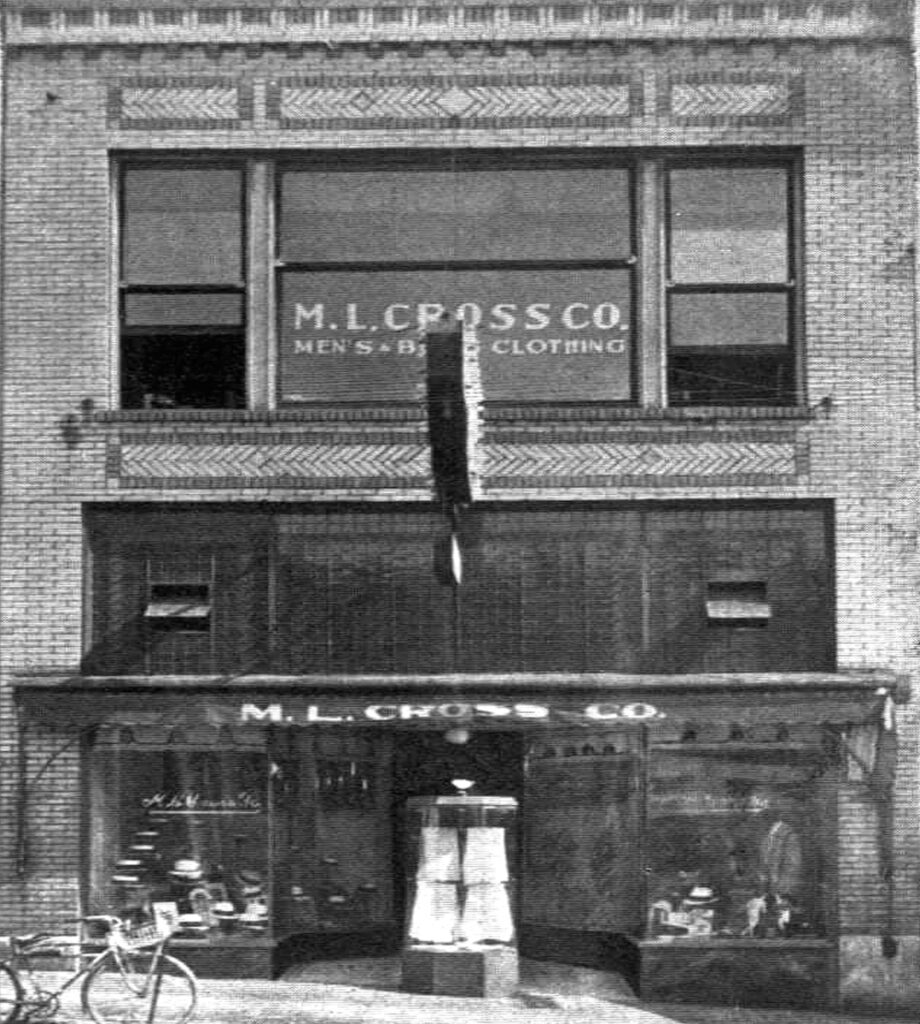
134 Franklin Street
Martin L. Cross and Sterling F. Beaumont opened for business in October 1893 as Cross & Beaumont, billed as the only exclusive men’s clothing and hat shop in Clarksville. The store, located at old street number 140 Franklin, had previously been occupied by Ware Brothers. A change in partnership took place in September 1894 when M. L. Cross sold his interest to his partner Beaumont with Beaumont continuing to conduct business as Sterling F. Beaumont. However, business reverses let Beaumont to close the store in March 1895 when he made an assignment to Bruce L. Rice as trustee. In April, Martin Cross bought the remaining stock of goods and “will at once open up in the gents furnishing goods line at the Beaumont stand.”
In February 1897, Martin Lee Cross and Susan Henry Martin were married in Desha County, Arkansas. Both families had long been locally prominent. Martin Cross was the son of George T. and Cordelia (Carney) Cross of Todd County, Kentucky. Susan Henry Martin was the daughter of George D. Martin and Susan (Henry) Martin, and granddaughter of Gustavus Adolphus Henry. M. L. and Susan had one son, Patrick Henry Cross, who at his death in 1966, gave “Emerald Hill” to the state of Tennessee for the use and benefit of then Austin Peay State College.
In 1897, nephew Charles C. Cross moved to Clarksville and in 1898 became a salesman at M. L. Cross. William Andrew “W. A.” Quarles had already been serving as Mr. Cross’s assistant. In 1907, the M. L. Cross Company incorporated with all stock being held and controlled by M. L. Cross, W. A. Quarles, and C. C. Cross.
In 1914, the M. L. Cross Company erected a new store building at 140 Franklin Street. They temporarily moved to the old McNeal & Edwards store while construction proceeded. This was the fourth time major remodeling was required to accommodate growth of the store.
M. L. retired in 1927, and Charles C. Cross became president of the company, buying out both M. L. Cross and Mr. Quarles. At that time other company officers were W. A. Quarles, vice president, and R. L. Bourne, secretary-treasurer. W. A. Quarles left the company in 1941 to go into partnership with Glen H. Hughes in the firm of Quarles & Hughes, then located on Franklin Street. Martin Lee Cross died at his Clarksville home on 3 April 1952; Charles C. Cross died 30 September 1952, also in Clarksville. Charles W. Cross, son of C. C., had become a member of the company in 1946, and became president at the death of his father. In 1955 another major remodeling took place, and the familiar M. L. Cross signature went up on the front of the building. In 1955 officers of the company were C. W. Cross, president, Mrs. C. C. Cross, vice president, R. L. Bourne, secretary, and James L. Pardue, treasurer. After eighty-ones years of serving Clarksville, the M. L. Cross Company closed in 1973.
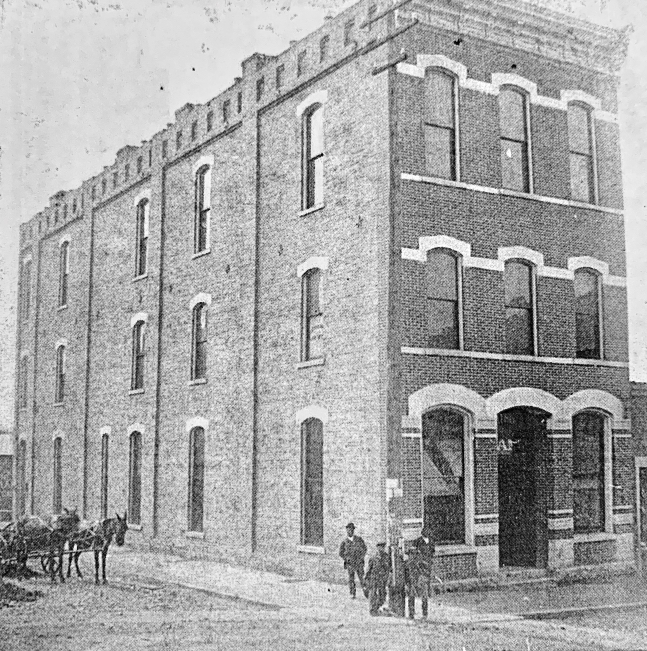
136 Franklin Street
Northern Bank of Tennessee – This bank was established in 1854. It was first known as Kennedy and Glenn, Bankers and Exchange Dealers. When chartered in 1854, it became the Northern Bank of Tennessee because of its geographical location in the state. It was chartered with $50,000 capital by two experienced bankers, David N. Kennedy, who became president and James L. Glenn, who became cashier. Mr. Kennedy had formerly been with the Branch Bank of Tennessee and Mr. Glenn had formerly owned a private bank on the east side of Public Square. This bank was first located in an old house on the west side of Public Square which later became John Young’s saddler’s Shop.
This was a bank of issue up to the Civil War, redeeming its notes in gold until United States currency was made legal tender. Thereafter it was redeemed in such currency until all its notes were retired. During the Civil War, Mr. Kennedy was still president of the bank. When he learned that Fort Donelson had been captured by Federal forces, he took action to preserve the bank’s assets. He put the assets in his saddlebags and left town in the dead of night headed for New Orleans. These assets were sent to England for safekeeping. Mr. Kennedy was experienced in packing money in saddlebags and traveling through the night in cold weather. Some ten years before in December, he had done it for the Branch Bank of Tennessee in order to bring needed funds from Nashville to Clarksville.
At the close of the Civil War, the bank’s assets were returned to Clarksville and the bank reopened. John W. Faxon became Assistant Cashier. The bank was now located in a building next door to its old offices. This building had been vacated by the Bank of America. During the Civil War, it had been used by the Provost Marshal of the federal forces. The Northern Bank was the first bank to offer loans based on the borrower’s credit rather than on the endorser’s credit. This was a revolutionary step in banking circles.
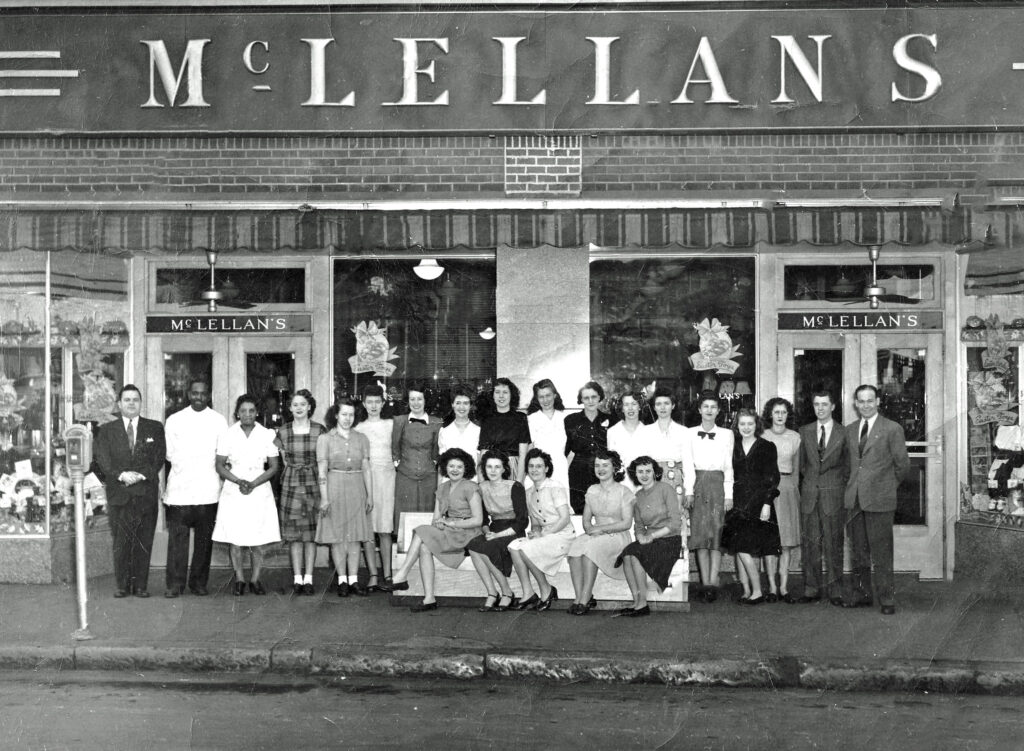
200 Franklin Street
Mclellan’s Department Store was located here after Askew Coulter & Owen Department Store. One of the things ACO, as it was generally called, sold was local school books. They had their own pencil OK tablet labeled ACO tablet. Mclellan was stocked with the usual variety of small items as Woolworths. Askew-Coulter-Hibbs owned the building in 1954, which was transferred to the L. B. Askew Estate.
Mclellan’s Extension was a portion of Mclellan’s Department Store. It actually was the old Askew-Coulter-Owen building and was owned by G. W. Coulter. It was situated on the Southeast corner of Franklin and Second Streets.
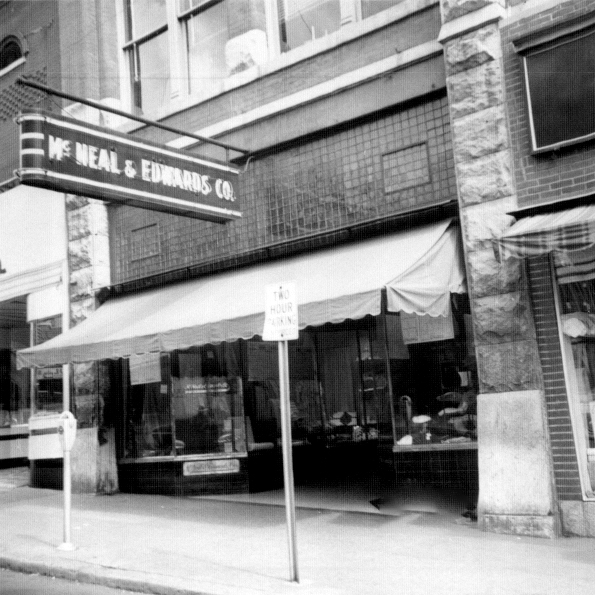
204 Franklin Street
McNeal and Edwards Company was known as an upscale home furnishings store. Frank E. Edwards was president; A. Gregg Olson, vice president; Walton P. Jarratt, secretary and treasurer. Mr. Jarratt managed the store. The firm later, opened a store at 409 Madison Street next to WJZM Radio, which included appliances.
At a time when king sized beds first became popular, it is said a lady asked for king-sized muslin sheets. The clerk responded they did not carry muslin sheets and if she could afford a king sized bed she could afford percale sheets. It is also said that the local prostitute madam ordered fancy lingerie from this store. In 1929, the company advertised dry goods, ready-to-wear, millinery, floor coverings, draperies and a beauty parlor. They had a bargain basement also.
Askew-Coulter-Hibbs owned this building, which they later sold to Mrs. Isobel Hibbs.
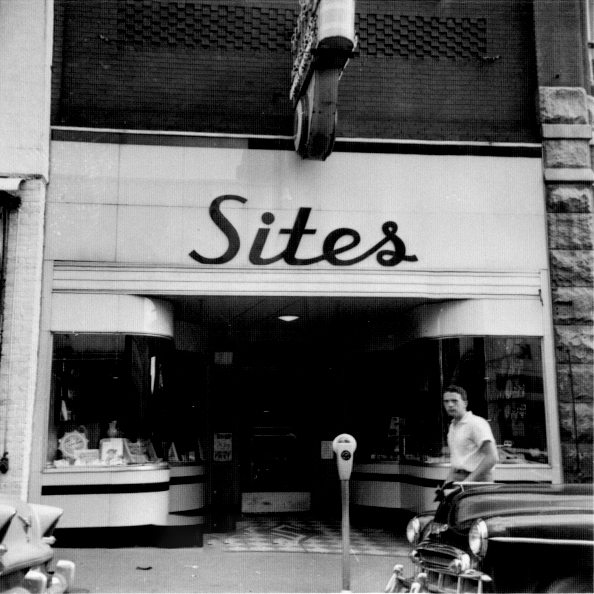
206 Franklin Street
C. G. Sites Jewelers was owned and operated by C. G. Sites, who came to Clarksville from Illinois. Clifton and Marie Sites were parents of three children: Marie, John and Jack Sites. Mr. Sites was born in 1890 and died in Clarksville in January 1974. His sons, John and Bill, continued to run the upscale Jewelry business after his father’s death. Son, Jack, became an optometrist.
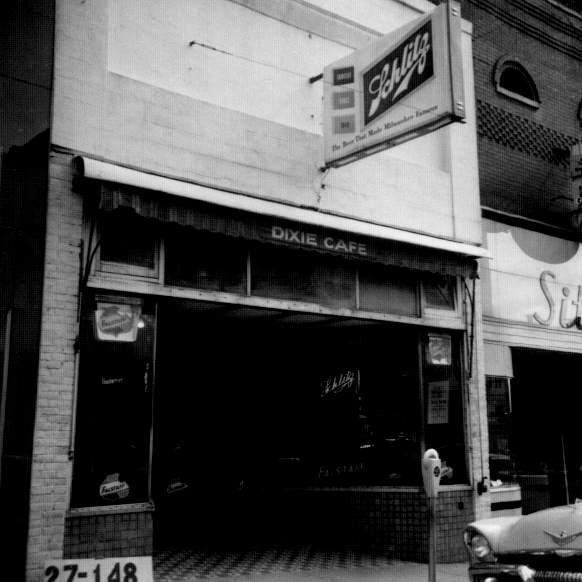
208 Franklin Street
The Dixie Cafe occupied 208 Franklin Street. It was located between Sites Jewelry Store and Mademoiselles. Harold M. Lester operated it. Sam Sardis, Jr. owned the building.
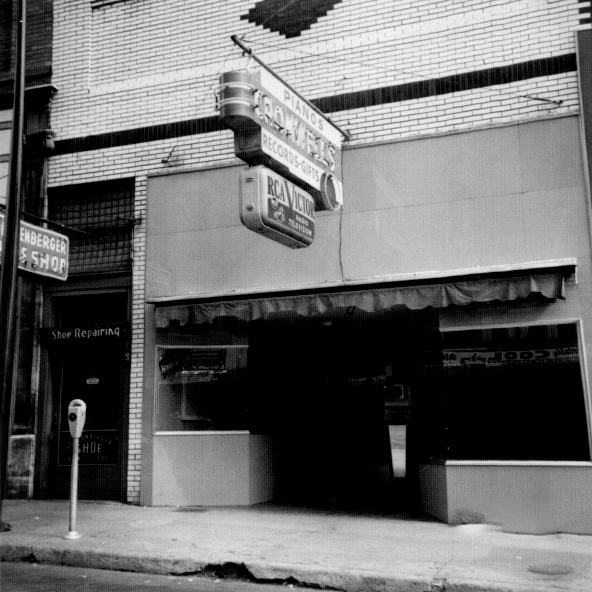
212 Franklin Street
Cromwell’s carried a supply of music merchandise as well as jewelry and gifts. J. Thurston Cromwell managed the store in 1954. Thurston Cromwell was a son of Percy F. and Ada Cromwell, who came to Clarksville from Kentucky. Mrs. Carrie Cook owned the building in 1954, which was transferred in 1970 to Mrs. Mary C. Foust.
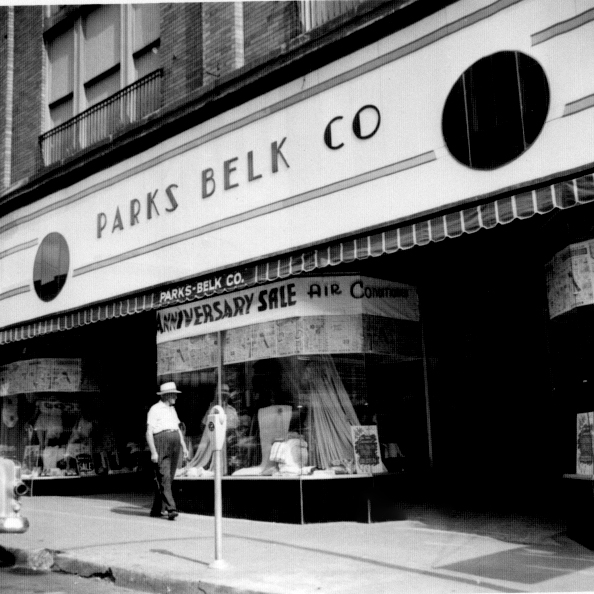
214 Franklin Street
Ben C. Parks was vice president and general manager of the popular Parks-Belk Company, which was located on the west side of Dickson-Sadler Drug Store. It carried a better grade of ready-to-wear clothing – both for men and women. In 1945 Ben C. Parks was vice president and general manager.
The site occupied by Parks-Belk had previously been occupied by Capitol Theatre. The building was owned by The Crescent Amusement Company, who sold it to Kim F. Jew.
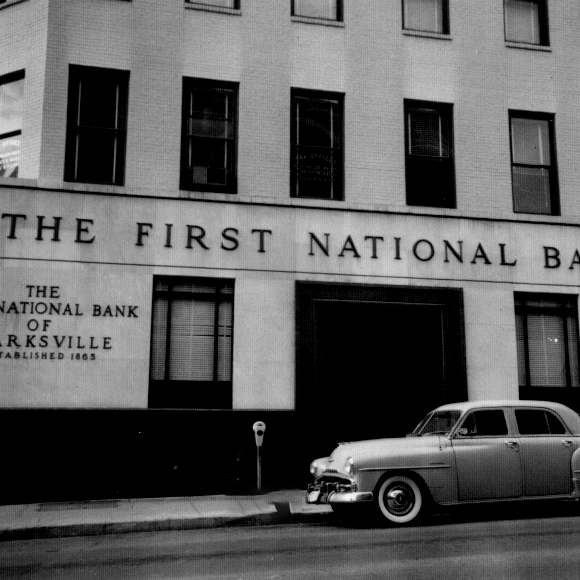
203 Franklin Street
First National Bank owned and used this building for a bank, which was established in 1865 right after the Civil War. The building was situated on the northeast corner of Franklin and North Second Streets. It was a three-story brick building with a wide stairway on the east side of the building next to Cotham Hardware Co. The bank was on the lower floor. Upstairs in 1954, were offices of Southern Trust Company, McReynolds and Marks Law Office, James G. Holleman Insurance Office, and Caldwell, Conroy & Marable (the forerunner of Conroy, Marable & Holleman) Insurance Offices. Brown Harvey, Sr. was employed by the Southern Trust Company at that time.
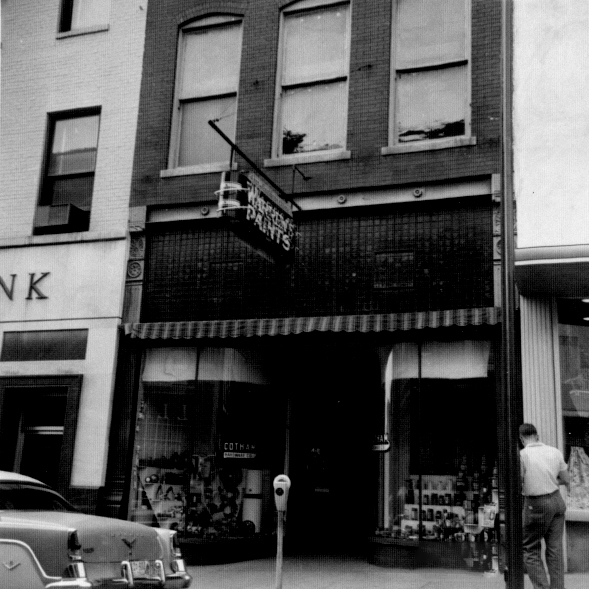
205 Franklin Street
J. C. Cotham was a clerk in Nichol’s Grocery Store at 823 Madison Street as early as 1895, where Cooley’s store later was. Every person that ever attended Clarksville High School will remember where Cooley’s was. Afterward, Mr. Cotham moved his business to 205 Franklin Street. He married Clara Gaisser and had children Clara, James, Gladys and Mary F. He died in December 1971 after having continuously operated a hardware store most of his adult life. Harry C. Gerhart owned the building, which joined the walls of the First National Bank building.
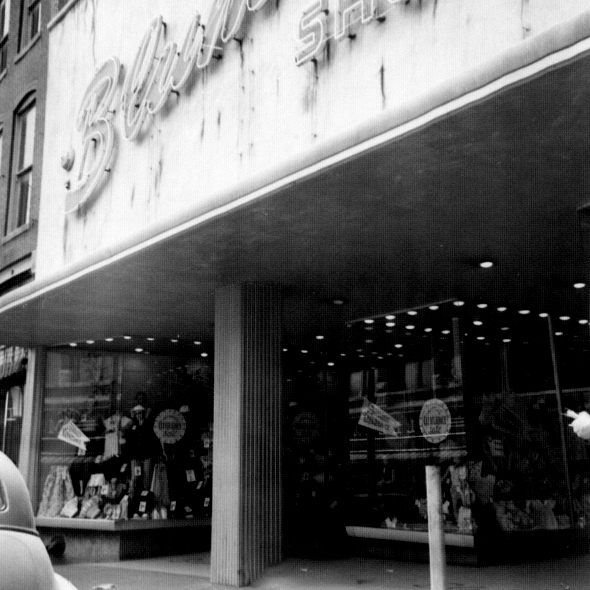
207 Franklin Street
Nathaniel V. Gerhart & Sons Isaac P., Charles C., Joseph H., Harry C., Bayless W. Gerhart & a daughter Ludia, who married Thomas Cross, operated a dry goods store in Clarksville, selling 25,000 pairs of shoes in one year. The store was on Franklin Street between Kuhns and Crow’s Jewelry Store. It was 66 feet wide with three entrances, three stories, and 135 feet deep reaching from Franklin Street to Strawberry (Legion) Street. The Gerhart family came to Clarksville, Tennessee from Gettysburg County, PA, through Louisville, KY. J. Z. Miller managed the store in 1954.
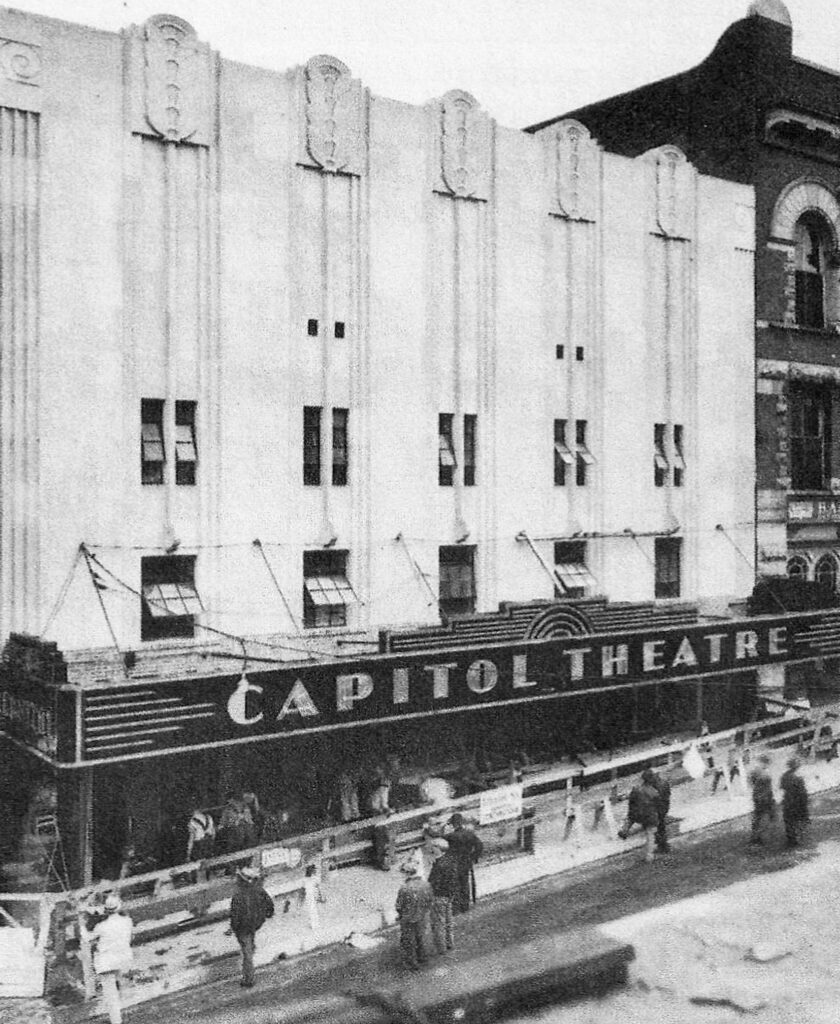
213 Franklin Street
Crescent Amusement Company operated two theaters in Clarksville – the Roxy & the Capital, which offered movie entertainment for people before television. On Saturdays, western movies drew young people to the theaters, who had saved their spending money in order to attend the “picture show” as it was called then. Crescent Amusement Company held a monopoly on movie theaters throughout the south until that monopoly was broke_n in the federal courts by the United States government. The Martin Theatre, Inc. purchased the Crescent Amusement Company’s franchise.
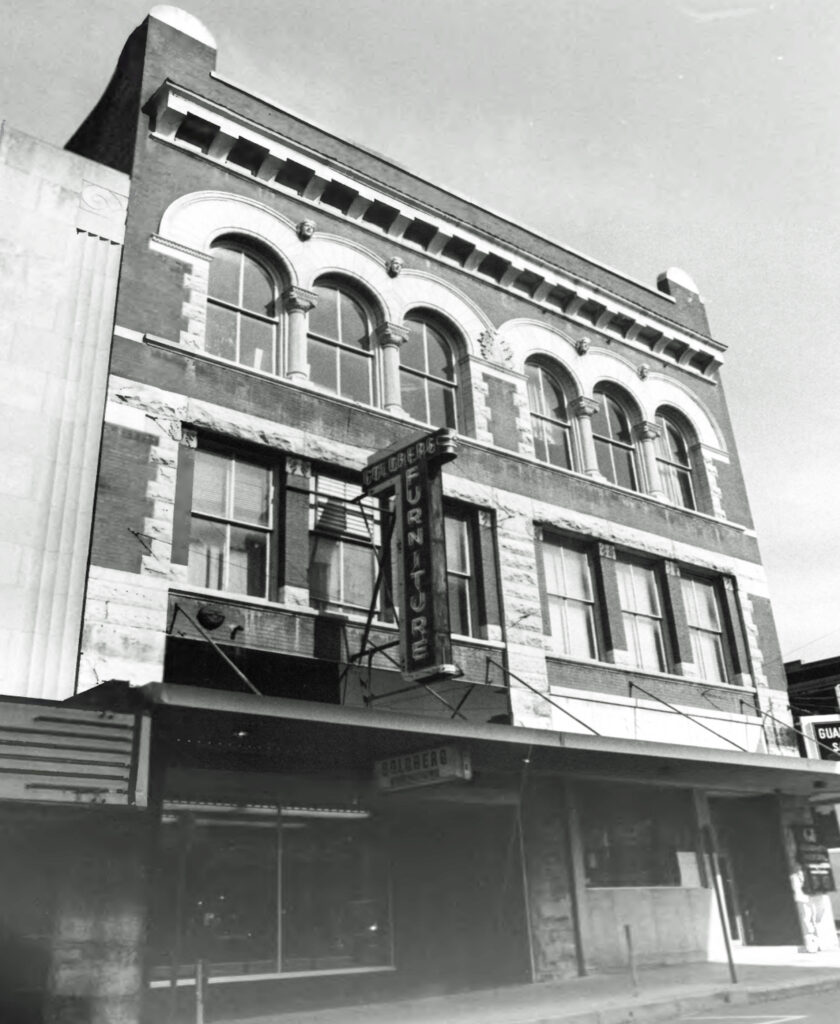
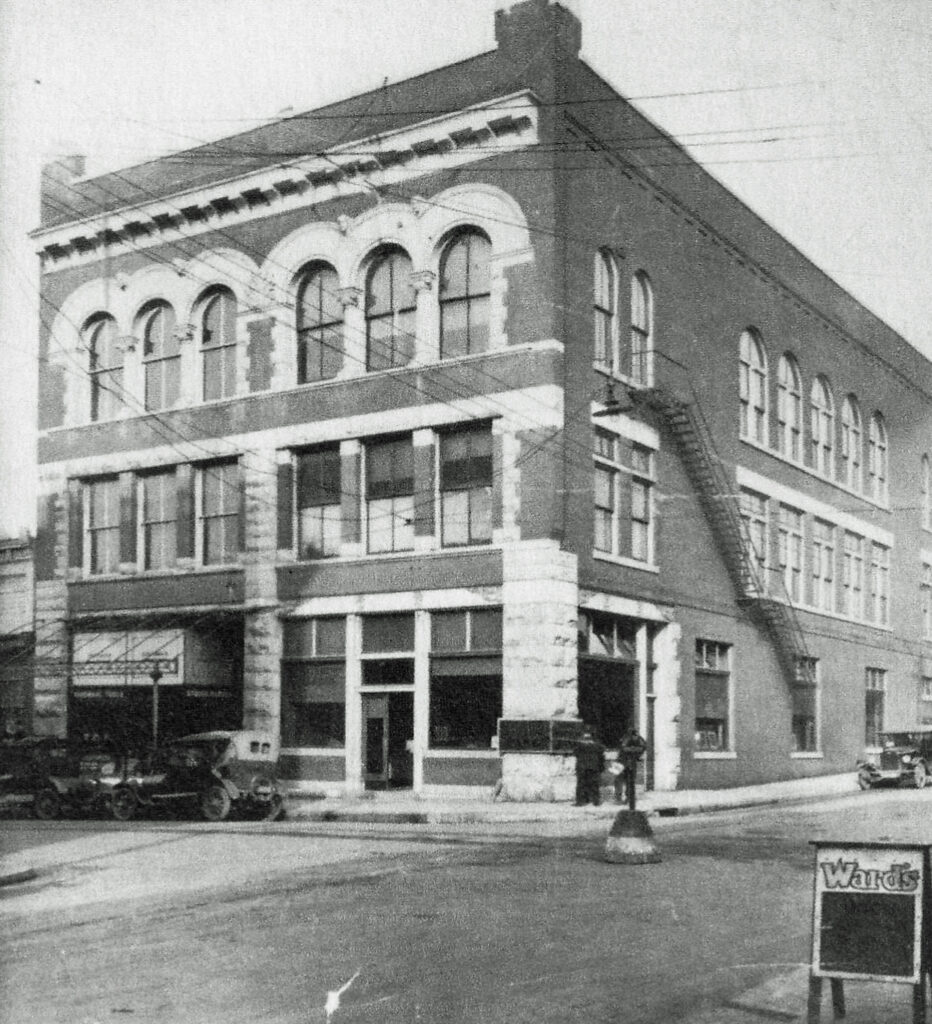
215 & 217 Franklin Street
The cornerstone of the Knights of Pythias building was set on 28 Oct 1890. Designed to be Clarksville’s first civic auditorium, its first large reception was held on March 31, 1892, to unveil the completed structure to the community. The first floor was to be a banquet hall and the second floor was to be used as a ballroom.
The Knights of Pythias occupied the 3rd floor of 217 for its meetings and rituals. The large reception room was furnished like a parlor with elegant furniture provided by John F. Couts with a handsome carpet covering the entire floor. The high ceilings, large windows and doors were enhanced with embossed satin walnut trim and finely carved wood wainscoting.
The Knights of Pythias rented out other spaces. The earliest tenants sold dry goods, millinery, and groceries. For several years, it was also home to the Elks Club. Built as a duplex, the two sections have been owned by separate parties in recent decades.
The west section, 215, was home to Joe Goldberg’s Furniture from January of 1908 until his retirement in 1917. Dickson Hardware operated there for five years until early 1925.
B. A. Cushman purchased the 215 building and opened a department store in August 1925, offering ready-to-wear clothing, shoes, millinery, piece goods, toys and more. An innovative and energetic businessman, Cushman had operated a 3rd Street which had grown and diversified over time. This location offered the space for a substantial expansion. In addition, he maintained a #2 store at 116 Franklin.
B. A. Cushman the retail space by another 800 square feet by adding a mezzanine above the first floor in May 1930. Later the same year, a beauty shop was added to the store’s amenities.
Ralph Goldberg, son of the earlier owner, bought the 215 building in January 1947. He remodeled and modernized the building, creating the angled entrance. In March 1959, another Goldberg’s furniture opened at the same location.
First Trust & Savings Bank relocated to 217 Franklin in February 1921, its third location. It began operation in 1906 on S. 2nd Street by the Arlington Hotel and moved to the SW corner of Franklin and 3rd in 1918. After over 50 years on the NE corner, 217, First Trust moved to 215 Legion Street by July 1972, became Commerce Union Bank in 1982, later Sovran and is now Bank of America. That building has been demolished and the location is part of the Downtown Commons.
Guaranty Federal Savings & Loan opened at 217 in 1983 and was a tenant until 1988. The Knights of Pythias sold the building in 1993.
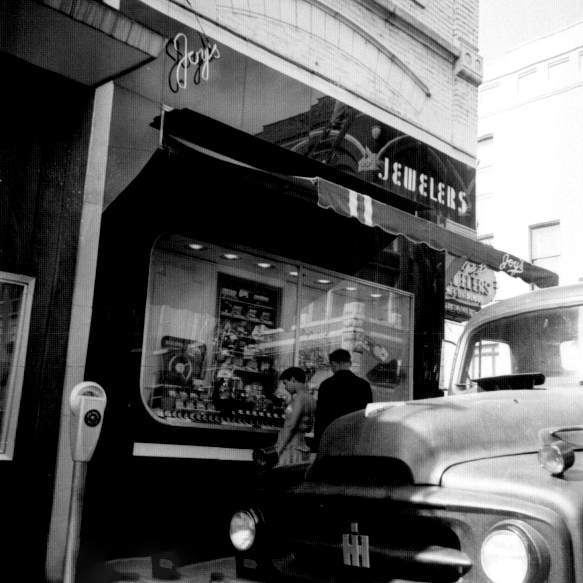
139 Franklin Street
Built by Samuel Hodgson after the 1878 fire, its first occupant was the Farmers’ and Merchants’ National Bank, not affiliated with the current F & M Bank, and later Clarksville National Bank from 1895 through at least 1929 when it merged with First National Bank which was directly across on the NW corner of Franklin and 2nd Streets.
139 was the home of Joy’s Jewelers from 1939-2008 under 3 different owners, 50 of those years by Wilson and Alice Goodrich. You might assume the business was named after their daughter, but instead, Joy Goodrich was named after the store.
The building is not readily recognizable when compared to its 1878 edifice. Many of the original architectural elements have been stripped off through the years.
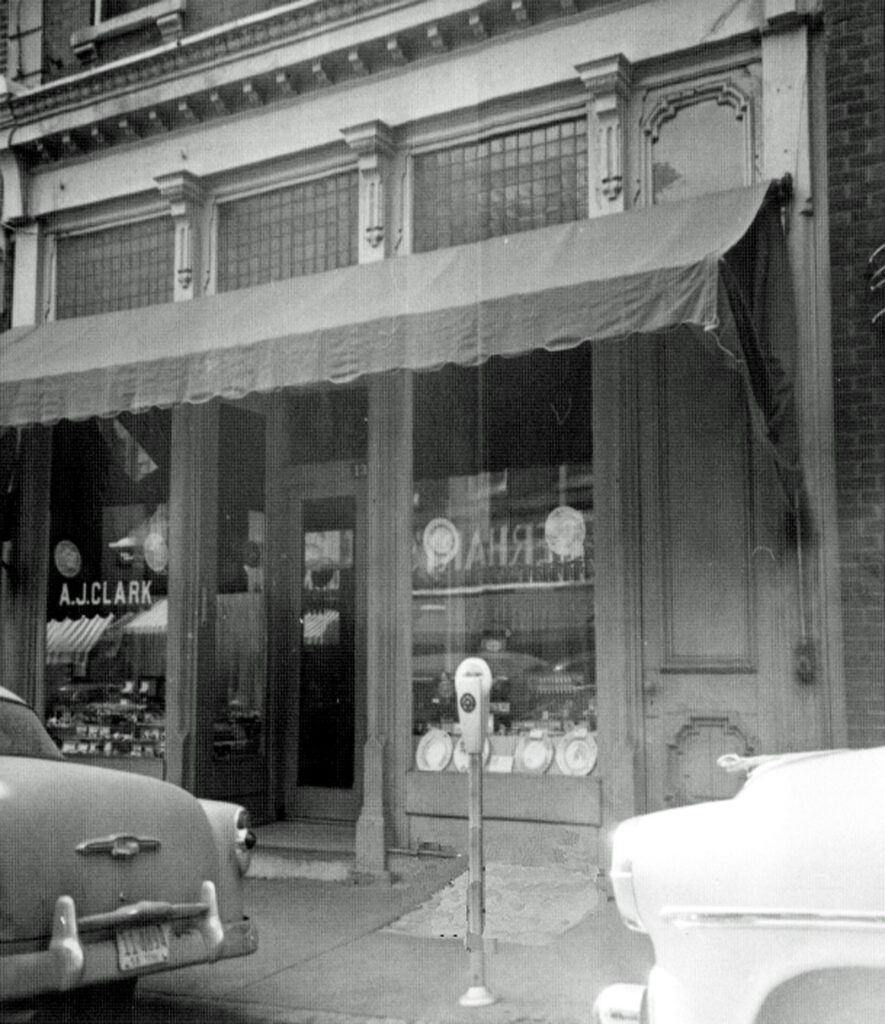
131 Franklin Street
A. J. Clark Jewelry Company
Unlike most of the buildings on Franklin Street, this well preserved three-story Italianate Victorian structure has undergone a minimum of alterations the only significant change is the addition of a modern metal canopy was built in 1878 by Samuel Hodgson on a portion of the site of the third courthouse for Montgomery County. This third courthouse was built in 1842 and had a spacious front lawn. It burned in the fire of 1878 which destroyed much of downtown Clarksville.
The brick and stone of this building as well as the iron have well withstood time and the elements. Neither the facade, nor the interior, nor the natural color of the brick has been altered. The window heads and cornices are among the largest and most elaborate on Franklin Street
The building has served as a jewelry store since March 15, 1902. Prior to that Lehman’s European Hotel and Saloon occupied this building.
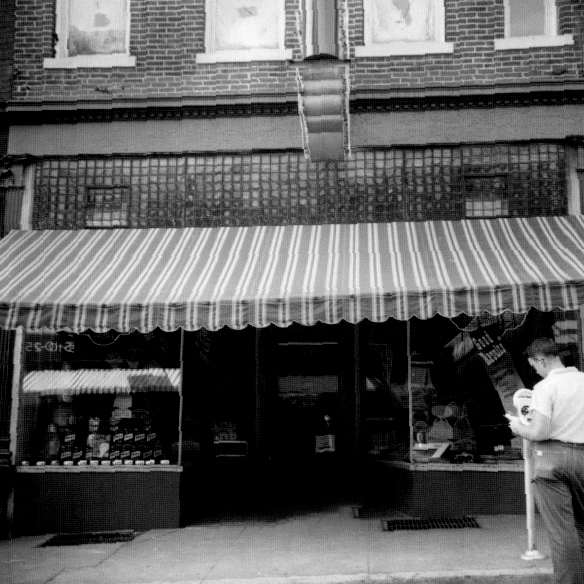
129 Franklin Street
The Wall Paper & Paint Store was owned by Edwin R. Smith. Edwin R. Smith was a brother of Ursula Smith Beach, Montgomery County Historian for many years. They were children of Ed. T. & Phoebe Smith. This building belonged to the Dr. M. L. Hughes Estate, eventually transferring to Clarksville Memorial Hospital.
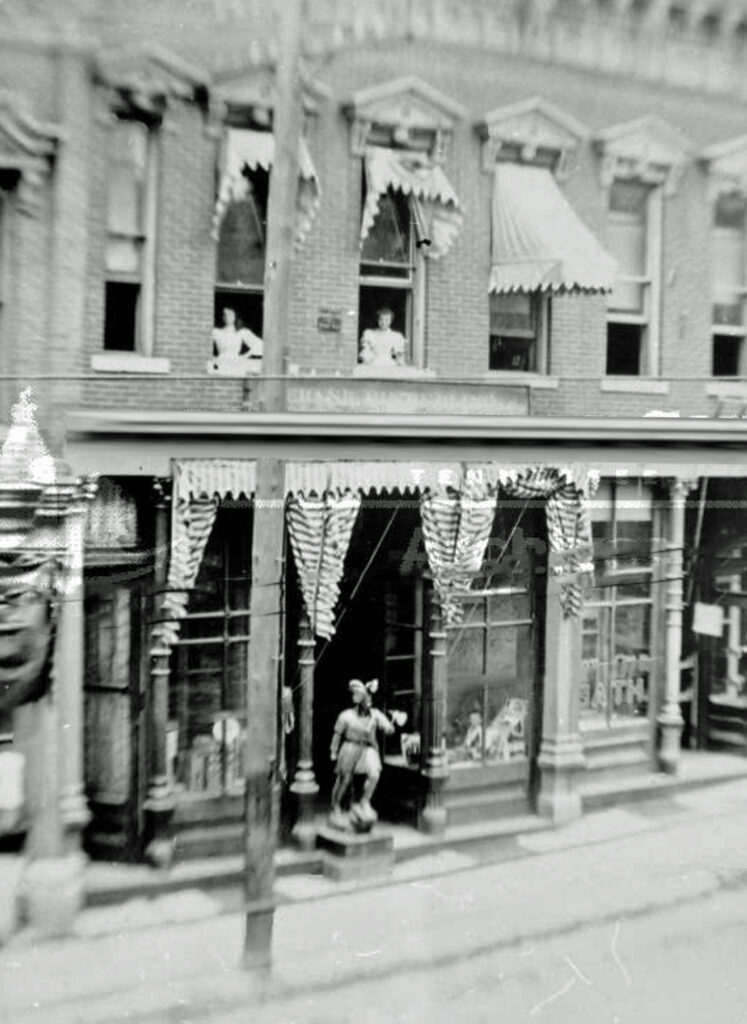
127 Franklin Street
Fiederling’s Cigar Store has the distinction of having been operated at the same location by the same owner for 55 years.
For many of those years, the entrance was hallmarked by the traditional wooden Indian, symbolizing the introduction of tobacco.
Frank Fiederling opened the store in 1881, soon after arriving in Clarksville from his hometown of Henderson, KY. He manufactured cigars in addition to selling them and other tobacco products. The store was also a gathering place for conversation and checkers, off limits to women except for the holiday season when they would be buying tobacco gifts for the men on their Christmas lists.
After his father’s death in 1936, Frank, Jr., and his mother Emma continued the business through 1954, a total of 73 years.
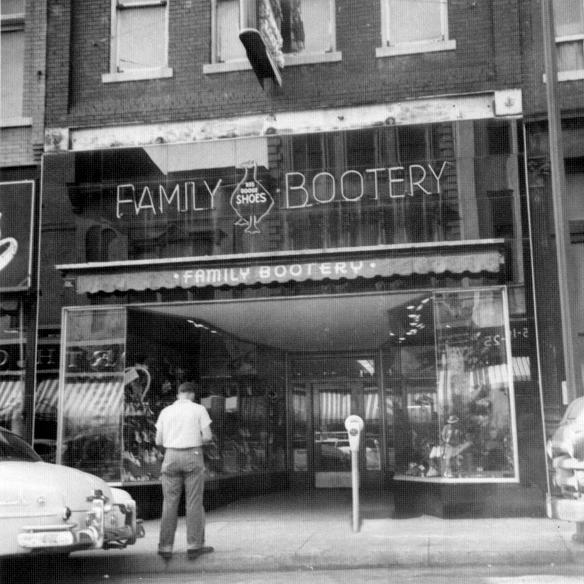
125 Franklin Street
Gossett & Rollow Furniture and Undertakers relocated from 109 Franklin to the newly constructed building at 215 Franklin in 1911. They appear to have remained there with a series of partnership changes through 1928.
Quarles and Hughes Fine Men’s Wear operated there until August 1951 when they moved to 3rd Street.
Family Bootery was the next business to take up residency there (1951-1965) followed by H. G. Highsmith Shoes from March 1966 through 1977.
In 1987, Clarksville Antique Mall relocated from 3rd Street, transitioned to Neblett’s Frame Outlet & Antiques Store, and later to Neblett’s Frame Shop which remained in business through 2005.
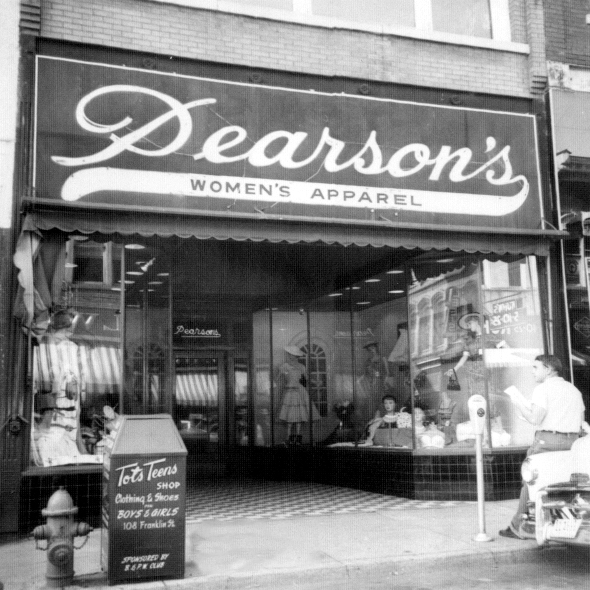
123 Franklin Street
Simon Katz operated a clothing and shoe store in 123 Franklin as early as 1891. A. Pearson & Bro, who had opened a five and ten-cent store at 137 Franklin in 1898, bought out Katz’s stock in June 1900 and began a clearance sale at that location. They also consolidated their stock from 137 to 123 and announced they would be opening a department store there in the fall. The new Pearson’s held its millinery opening in Oct 1900. It apparently carried a more up-scale line of goods than the previous establishments since by 1903 was advertised as The Palace.
A July 1911 fire destroyed the building forcing a temporary relocation. The building owner Mr. Dulaney welcomed Abe Pearson’s participation in the planning of a building suited specifically for his business. Pearson’s department store, specializing in women’s ready-to-wear, thrived for almost 70 years at 123 Franklin, closing in 1968.
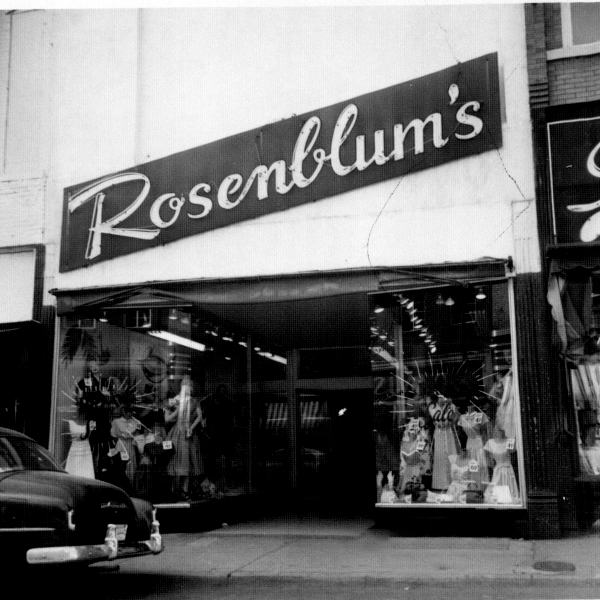
121 Franklin Street
From the 1880s through the 1940s, 121 Franklin housed a series of businesses selling dry goods, groceries and liquor; business owners included Pickering, Hanratty, Rubenstein, Schindler, Tilley, Russell, Tarpley, Smith, Stamm, Falk, Goldberg, and McGregor. Barbers, tailors, and other businesses often rented separate spaces, especially on the upper floors, of this and other downtown buildings. Rosenblum’s began a women’s clothing store tradition in 1950. Ted Seloff, who was the manager of competitor Davis Ladies’ Shop, bought Rosenblum’s stock and lease in 1958 and opened Ted’s Smart Styles. In July 1965, Bill Brent, who ran the shoe department at Lee’s Ladies Shop, opened Bill Brent Fashions offering famous name brand shoes, casual, and sportswear for women. Brent’s relocated to 136 Franklin in 1995.
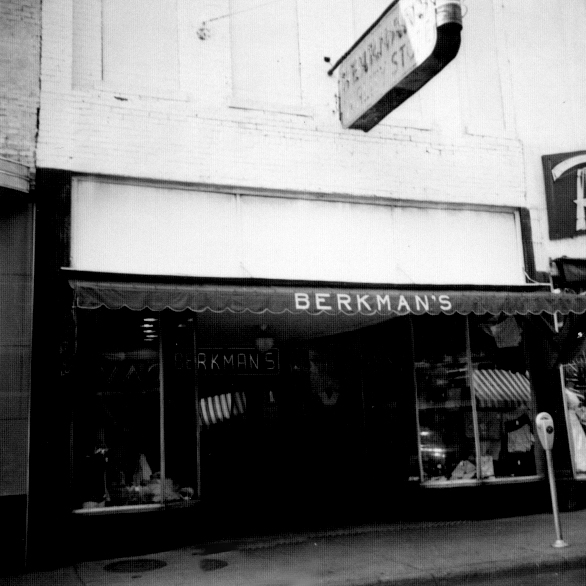
119 Franklin Street
119 Franklin was a series of drug stores in the 1890s, T. A. Thomas, Tudhope, and Leigh & Co. Drugs. It was also S. Klass dry goods and Kitson’s Music house, selling pianos, organs, other instruments and sheet music.
From 1903 through 1919 it was W. W. Winters Steam Bakery and Restaurant. The successful business added candy making in 1905 and ice cream in 1908. 1910 brought a building remodel plan to extend the rear to Strawberry Alley in order to accommodate a 5000 loaves/day capacity oven, enlarge the front windows, double the size of the dining room, and renovate the cellar for a large electric motor to automate some of the work and double the ice cream production. In 1910, they added a modern soda fountain counter at a mirrored wall. In 1919 Mr. Winter sold his business and relocated to Louisville, KY.
Berkman Brothers’ Quality Store opened at 119 Franklin in September 1922. It sold a variety of goods including adult and children’s clothing, bedding, towels, drapery, linens and yard goods. Samuel Dryer purchased the business in 1949 and continued operation under the name Berkman’s until December 1979, ending over 57 years of retailing.
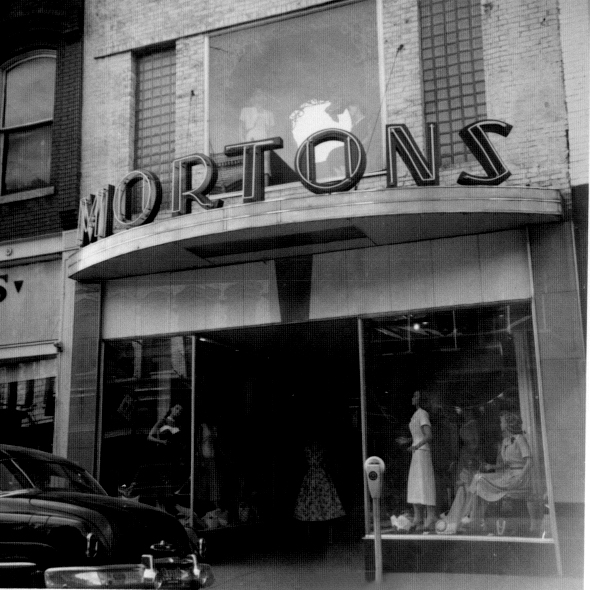
117 Franklin Street
In the fall of 1890, T. A. McGehee’s grocery and dry goods store was devastated by an early morning fire. He and his four brothers had built seven successful stores within the “Clarksville Tobacco District.” That spring, a cyclone and subsequent fire destroyed the Bellview, KY store and killed one of the brothers. With the Clarksville house holding a large number of goods for distribution to the other stores, the two losses exceeded the insurance coverage causing the firm to liquidate assets to satisfy creditors. Remarkably, by mid-December, McGehee’s was restocking and followed with a grand spring opening.
Morton’s ready-to-wear women’s clothing store had operated for nine years at 124 Franklin before relocating to this location in Nov 1947. The front and interior were remodeled in “street California design” with custom-designed fixtures.
From 1958 to 1973, it housed Lane’s Ladies’ Shop, which was owned and operated by Morton’s longtime manager, John Lane.
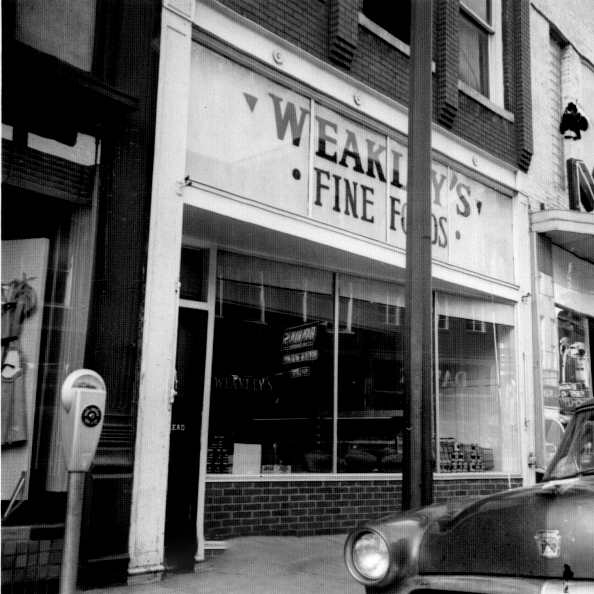
115 Franklin Street
115 Franklin was a grocery store, from at least 1888 through 1955. In the 1890s it was a livery stable and feed store that also sold groceries. Business owners included A. S. Wood, J. D. Coleman, and G. W. Scarborough in addition to Weakley.
The fire in 1904 destroyed the building and all the stock of the current occupant, W. S. Russell. He managed to set up temporary quarters a mere three days later to be back in operation with new supplies.
In later years, it was a Sears Catalog Store (1955), The Remnant Store (1957-1967), and then became part of Brenner’s Colonial Furniture which occupied 105, 110 and 115 Franklin Street in 1970.
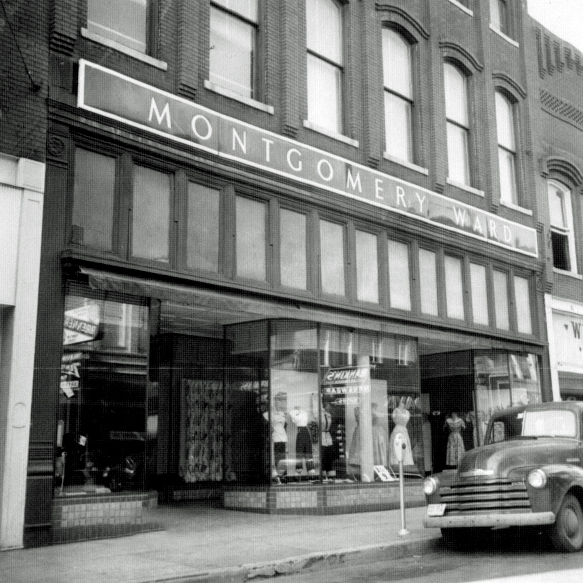
111-113 Franklin Street
N V Gerhart came to Clarksville from Louisville having had heavy losses from the Panic of 1873. He started a small store at the corner of 1st and Franklin. His good business practices and investing his gains back into his store steadily grew his operation. Less than two decades later, N V Gerhart & Sons was one of the most successful “Mercantile Emporiums” in the area. After 1878, he occupied 113 Franklin through to Strawberry Alley. Thriving trade supported expansion to an adjoining building and then a third by 1891. In 1904, a fire destroyed the 1878 buildings. N V Gerhart’s Sons, so named after their father’s death in 1895, built the current structure, later occupied by Montgomery Ward from 1929-1965.
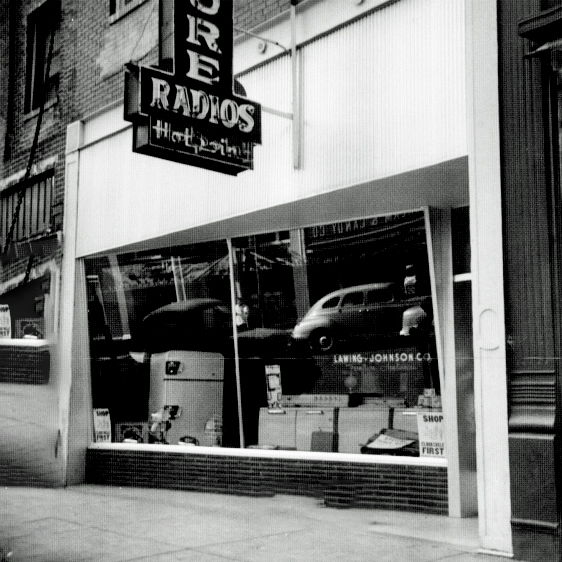
109 Franklin Street
Dry goods and furniture stores alternated at 109 Franklin until settling on furniture in the mid-1920s. It was Garvin’s Furniture 1925-1928, The Exchange Furniture 1929-1935, and Lawing & Johnson 1935-1959.
In 1970, business owner Charlie Morrison closed his 3rd Street store and leased 107 to join with 109 offering 6 floors of furniture as Lawing-Johnson-Garvin. He advertised 100 years of service in 1974 and continued until 2000.
Mildred and Mable’s opened in July 2001.
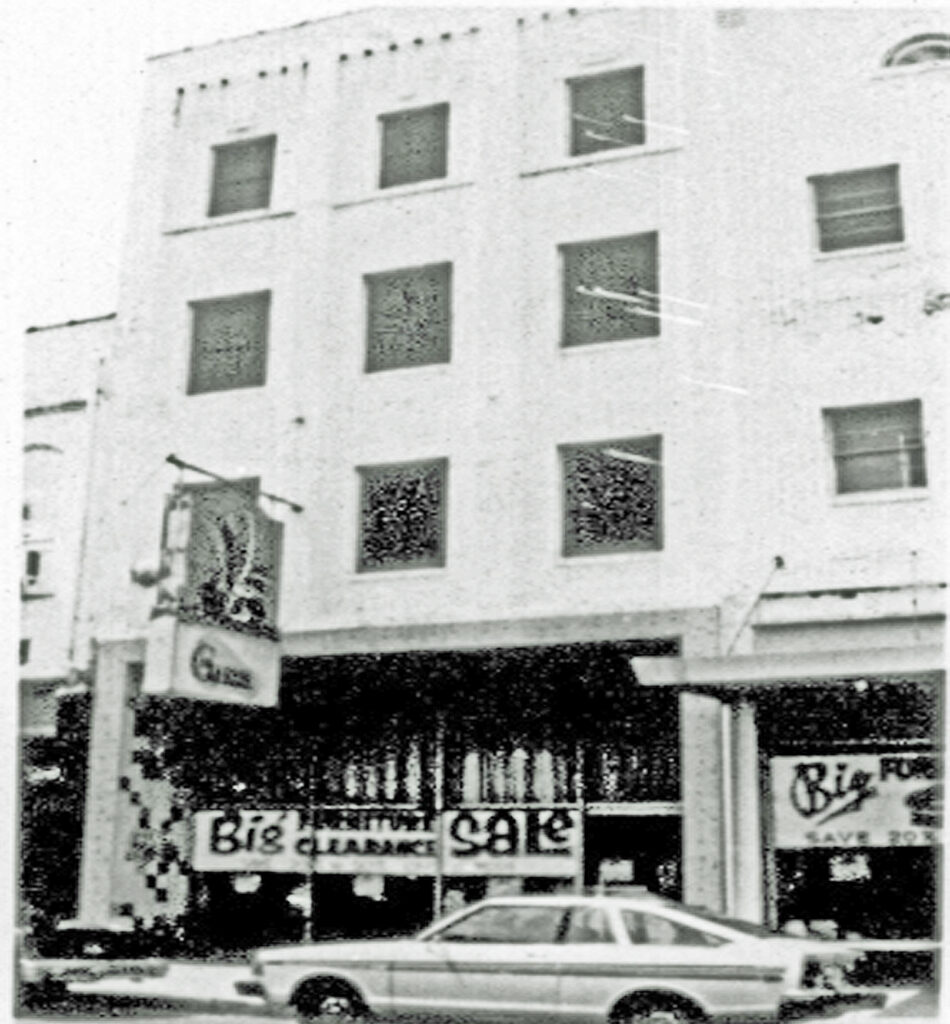
107 Franklin Street
107 Franklin was a furniture store location since early times. John Couts, whose furniture and undertaking business was on the Public Square from 1845, moved it to Franklin Street in 1872. That building was destroyed in the 1878 fire. Its replacement became John Couts’ Son (Commodore F. Couts) Furniture and Embalming in 1897.
It was the Garvin Furniture Store from 1923 and for over 50 years. Occupying 107-109 in 1974 as Lawing-Johnson-Garvin, it was advertised as having served Clarksville for over 100 years.
The current occupant, Edward’s Steak House, opened in March 2009.
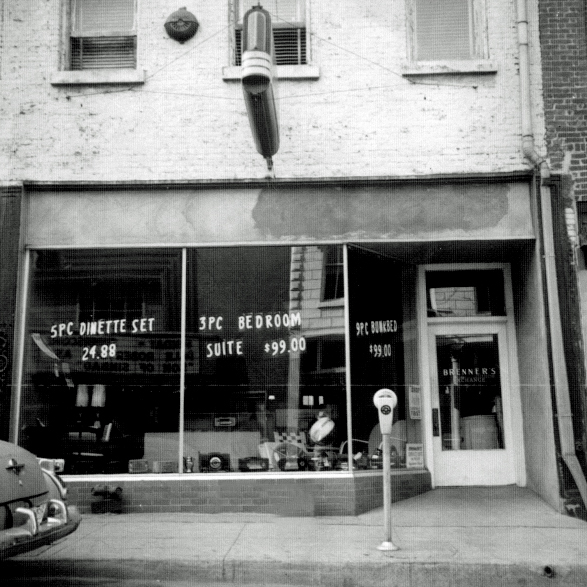
105 Franklin Street
In the 1890s, 105 Franklin was Adams and Neblett Feed & Groceries; later, a dry goods store, A F Joiner Grocer, Clarksville’s Popular Price Store and then a coffee shop.
Brenner’s Furniture was opened in 1919 by brothers Reuben and Mose, both born in Russia, Brenner’s Furniture store occupied 105, 110, and 115 Franklin for years. In 1925, water from a fire at Bilsky’s dry goods three stores away poured down the street and flooded the basement level of 105 causing massive water damage to thousands of dollars worth of furniture. During the 1950-60s, 105 was the used furniture store; 110, new furniture.
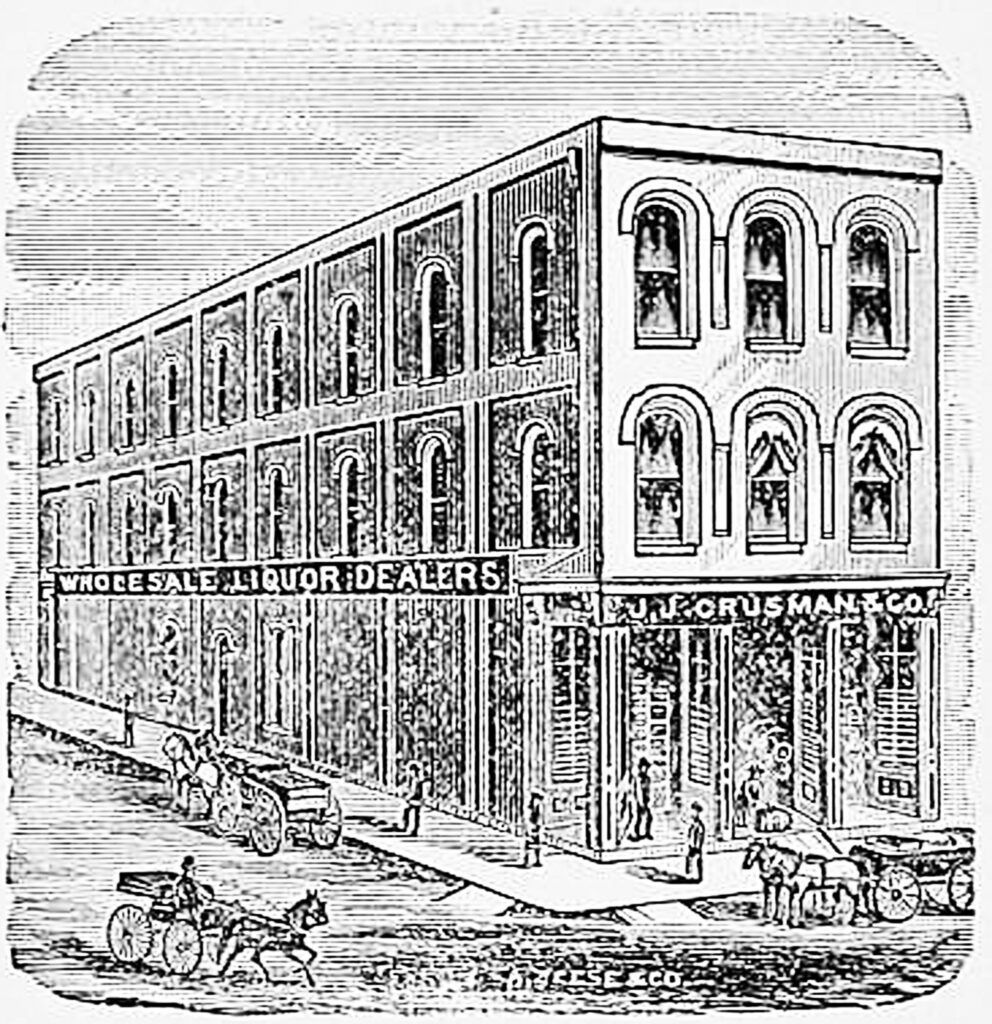
101 Franklin Street
James J. Crusman began working in the grocery business in the 1850s, retaining his position as a series of operators bought, sold and transferred business ownership. In 1860, Carr & Broadman sold out to Crusman & Johnson, then Johnson sold his interest to Charles Mitchell in 1861. Mitchell and Crusman were good businessmen with promising futures, but six months later they left others to liquidate their business and volunteered as privates in Co. H of the 14th TN Regiment of the CSA.
Crusman returned to Clarksville in August 1865 and with partner S. P. Chesnut built a successful wholesale liquor and grocery trade in the difficult post-Civil War years. Always an enterprising businessman, he helped defy expectations that Clarksville would never again be a competitor in the regional markets. Elected Mayor in 1878, he brought the struggling city out of debt to a sound financial footing and improved public resources. The over 150-year-old building that carries his name retains many of its original design elements. In addition to groceries, it has housed a variety of enterprises ranging from feed, clothing and dry goods sales to restaurants and a rifle range.
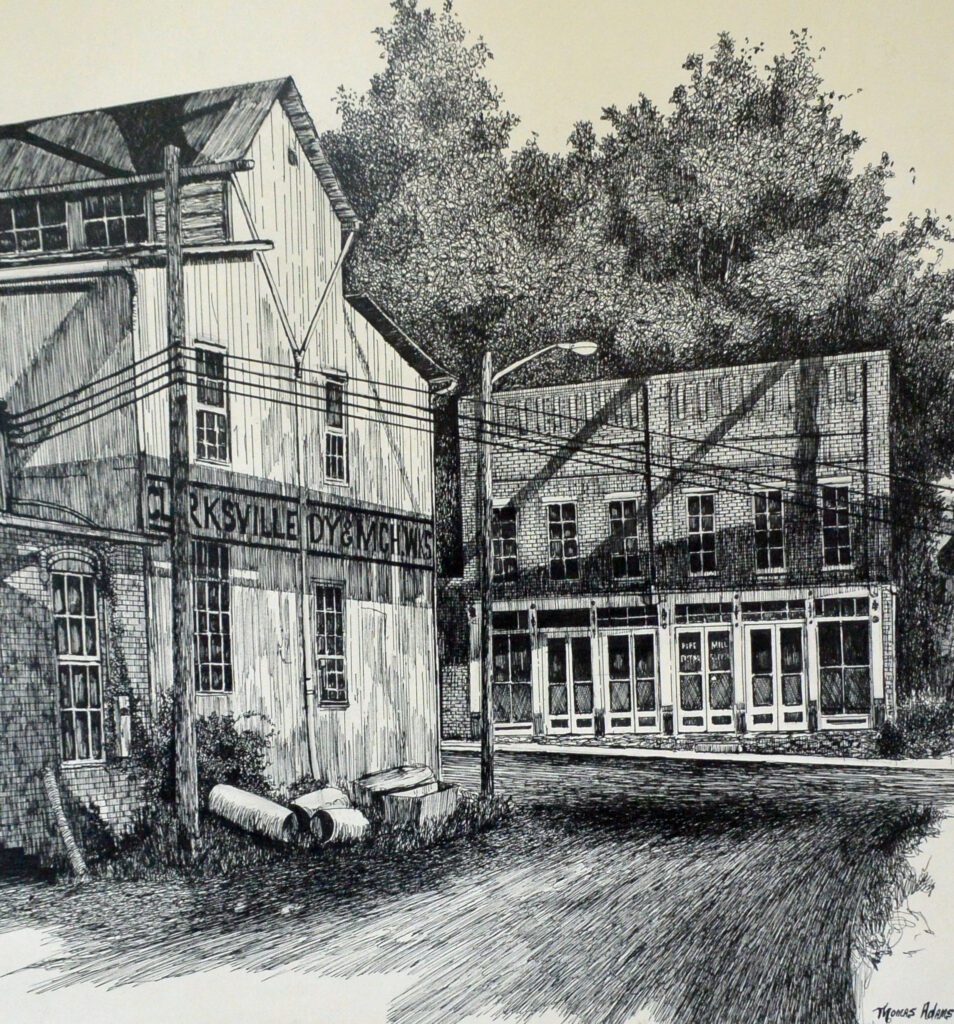
136 Commerce Street
Situated in 1845/6 next to the city’s town spring on the corner of Commerce Street and the often rutted dirt road that later was appropriately named Spring Street, H.P. Dorris began a business that has up until 2022, operated under many partnerships and challenging economic times. What began as the Clarksville Foundry and Machine Shop became known as Whitfield & Co., Whitfield, Bradley & Co., Whitfield, Bates & Co., Drane & Co., Drane Foundry and Supply Co., and next Clarksville Foundry and Machine Works owned by Thomas B. Foust in 1912. Since then three generations of this family have operated the business and relocated to its present site on Red River Street. In the early years, there were between 8-17 men employed and at the time of WWII over 100 to meet production demand. Aware that fire was an ever-present danger to the wooden main building, the foundry’s office was built across Commerce Street to ensure that important documents and records would be protected.
It was at this foundry during the Civil War that munitions such as cannon balls, canisters and grapeshot as well as cannons (6 and 9 pounders), for the Confederacy were manufactured until the city was occupied by Federal soldiers. During the Dranes’ ownership in 1893, a heavy stone retaining wall was constructed at the back of the building at the bluff and the original annex in the rear of the main building was torn down.
In 2010, the foundry reproduced a section as closely as possible in its chemical composition to the exterior skin of the Confederate submarine H.L. Hunley in order to understand if shots from the USS Housatonic could have caused the damage seen on the wreckage which led to its sinking and disappearance. The replica piece was fired upon with period weapons under a controlled test.
A careful eye can spot evidence of this company all over the downtown from old manhole covers, and drainage grates to the replica of a Civil War cannon in the courthouse yard to the amazing artwork entitled, “Windows to the World” in the Clarksville Commons. The Clarksville Foundry today remains a viable business whose proud past is ingrained in the history of the city itself.
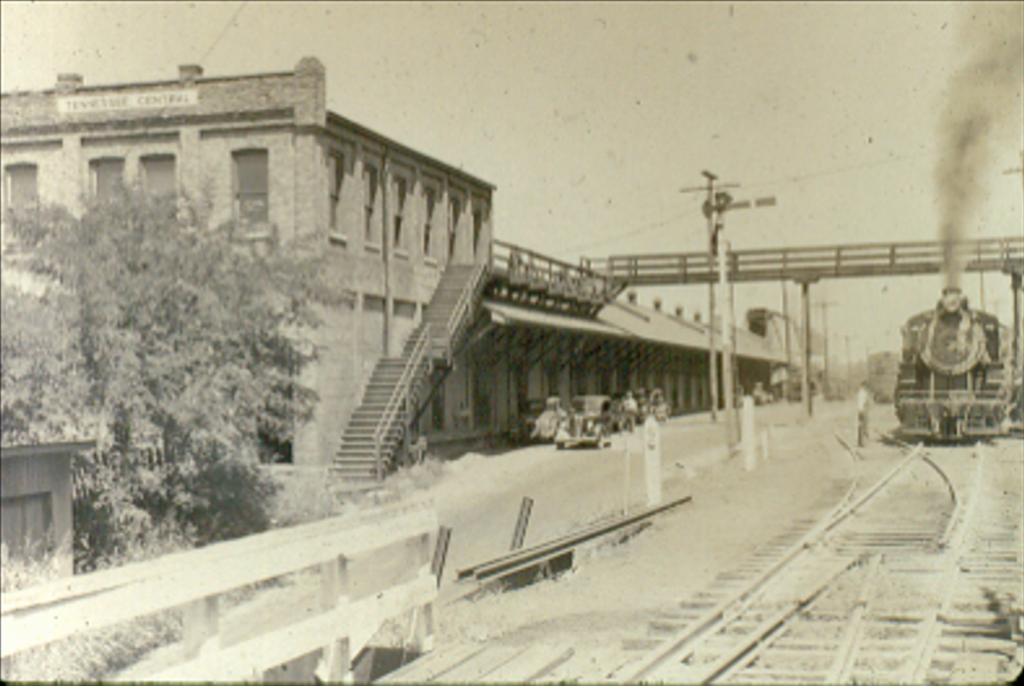
100 S Spring Street
Initially, in December of 1903 the freight for the Tennessee Central Railroad was received at a car located near the Tobacco Exchange Building on the Public Square. Then it was decided that the Tennessee Central would purchase the Tobacco Exchange building and convert it to a passenger depot with the additional rooms used as offices. Unable to purchase the county jail behind the Public Square the railroad looked in January of 1904 to other sites which to build a depot. In 1905 the Tennessee Central Railroad was leased to the Illinois Central Railroad which was able to purchase the property on which the jail stood on Spring Street and a new depot for the railroad was proposed. In early July 1906, Clarksville’s city council came to an agreement with the railroad for the construction of a depot. Due to the steep grade of the hill the depot was to be 400 feet long and 36 feet wide with a 40-ft. overhead pedestrian bridge from the west end of Franklin Street across Spring Street to the depot. This, to provide a convenient access to the Public Square with its hotels and the stores in downtown.
The cost to the railroad for the property was $26,000 and the estimated cost of the depot itself was $75,000. A retaining wall was constructed on the east side of Spring Street with piers for the pedestrian bridge.
In later years, the second story on the south end of the depot was removed as was the pedestrian bridge. The former Tennessee Central Depot building is currently owned by the City of Clarksville.
Thank you to our sponsors!
